Check out my custom vibration dampener
20+ Best Tennis Racquets for 2024
Playtested & Reviewed
We hope you love this article. Just so you know, TennisCompanion may collect a small share of sales from the links on this page to help keep this site running. Learn more.
Selecting the right tennis racquet can dramatically influence your success and progression as a tennis player. Get it right, and you’ll learn faster and have more fun, so it pays to do your research.
To help, I’ve narrowed down my picks of the best tennis racquets for 2024, all of which I’ve playtested and reviewed to provide detailed performance insight for better decision-making.
Along with essential tips, background info on my rating process, and related resources, I’ll equip you with everything you need to choose a racquet confidently, regardless of age or experience.
Here’s a preview of my top five picks for you to check out:
Click here to view my full list of all 23 racquets that make the cut.
Article Contents
Click below to jump to a section
Tap below to jump to a section
Racquet Comparison Table
Is This Guide for You?
Why I Created this Guide
Tips for Using this Guide
Intermediate vs. Advanced
How I Compare Racquets
Racquet Specifications
The Best Racquet for 2024
Wrapping up
New to TennisCompanion?
Create a free account and explore my latest videos below
Racquet Comparison Table
To help you navigate this resource and for quick comparison, I’ve included all the racquets I’ll discuss in the table below.
You can scroll left to right to view all of my ratings or click any of the links to jump to the section of the article where I discuss that specific frame and why it made my list of the best tennis racquets.
| Rank | Racquet | Serves | Volleys | Groundstrokes | Returns | Topspin | Slice | Power | Control | Comfort | Touch | Maneuverability | Stability | Overall |
| #1 | Babolat Pure Strike | 8.6 | 8.8 | 9.2 | 9.2 | 8.8 | 8.9 | 8.6 | 8.7 | 8.8 | 8.8 | 8.9 | 8.7 | 8.83 |
| #2 | Head Speed MP | 8.5 | 8.6 | 9.2 | 9.1 | 8.9 | 8.8 | 8.8 | 8.6 | 8.7 | 8.4 | 8.8 | 8.6 | 8.75 |
| #3 | Babolat Pure Aero | 9.0 | 8.3 | 9.2 | 8.8 | 9.5 | 8.6 | 8.8 | 8.5 | 8.1 | 8.2 | 8.9 | 8.4 | 8.69 |
| #4 | Wilson Pro Staff 97 | 8.5 | 9.1 | 8.7 | 8.5 | 8.4 | 8.9 | 8.2 | 9.3 | 8.6 | 9.0 | 8.1 | 8.8 | 8.68 |
| #5 | Yonex EZONE 98 | 8.6 | 8.6 | 8.8 | 8.5 | 8.6 | 8.3 | 8.2 | 8.9 | 8.6 | 8.7 | 8.5 | 8.4 | 8.56 |
| #6 | Head Gravity Pro | 8.3 | 8.7 | 8.6 | 8.6 | 8.4 | 8.9 | 8.0 | 9.1 | 8.8 | 8.7 | 7.7 | 8.8 | 8.55 |
| #7 | Wilson Blade 98 18×20 | 8.4 | 8.7 | 8.6 | 8.5 | 8.2 | 8.6 | 8.2 | 8.8 | 9.0 | 8.6 | 8.3 | 8.6 | 8.54 |
| #8 | Babolat Pure Drive | 8.9 | 8.3 | 8.6 | 8.4 | 8.8 | 8.3 | 9.1 | 8.4 | 8.2 | 8.3 | 8.7 | 8.5 | 8.54 |
| #9 | Wilson Clash 100 | 8.3 | 8.4 | 8.6 | 8.5 | 8.4 | 8.5 | 8.5 | 8.4 | 9.1 | 8.6 | 8.8 | 8.2 | 8.53 |
| #10 | Yonex Percept 97 | 8.3 | 8.3 | 8.7 | 8.4 | 8.5 | 8.7 | 8.3 | 8.9 | 8.5 | 8.7 | 8.5 | 8.3 | 8.51 |
| #11 | Yonex VCORE 98 | 8.4 | 8.6 | 8.7 | 8.6 | 8.9 | 8.4 | 8.5 | 8.6 | 7.9 | 8.3 | 8.3 | 8.4 | 8.47 |
| #12 | Prince Phantom 100X | 8.1 | 8.7 | 8.6 | 8.4 | 8.7 | 8.5 | 7.8 | 8.3 | 8.9 | 8.7 | 8.6 | 8.2 | 8.46 |
| #13 | Wilson Burn 100 | 8.4 | 8.6 | 8.7 | 8.4 | 8.5 | 8.5 | 8.6 | 8.4 | 8.0 | 8.5 | 8.5 | 8.4 | 8.46 |
| #14 | Prince Warrior Textreme 100 | 8.5 | 8.2 | 8.6 | 8.5 | 8.6 | 8.4 | 8.7 | 8.1 | 8.2 | 8.3 | 8.6 | 8.4 | 8.43 |
| #15 | Prince ATS Textreme Tour 100P | 8.2 | 8.7 | 8.5 | 8.3 | 8.5 | 8.8 | 7.3 | 8.7 | 8.6 | 8.7 | 8.3 | 8.4 | 8.42 |
| #16 | Tecnifibre TF-X1 300 | 8.2 | 8.4 | 8.4 | 8.2 | 8.6 | 8.3 | 8.6 | 8.2 | 8.1 | 8.1 | 8.7 | 8.2 | 8.33 |
| #17 | Head Extreme MP | 8.5 | 8.3 | 8.6 | 8.1 | 9.0 | 8.3 | 9.1 | 7.9 | 7.5 | 7.9 | 8.4 | 8.2 | 8.32 |
| #18 | Tecnifibre T-Fight 300 Isoflex | 8.1 | 8.4 | 8.5 | 8.1 | 8.4 | 8.1 | 8.1 | 8.3 | 8.1 | 8.4 | 8.8 | 8.3 | 8.30 |
| #19 | Head Radical MP | 8.3 | 8.3 | 8.5 | 8.2 | 8.5 | 8.2 | 8.5 | 8.5 | 7.8 | 7.8 | 7.9 | 8.6 | 8.26 |
| #20 | Wilson Ultra 100 | 8.4 | 8.2 | 8.5 | 8.3 | 8.5 | 8.0 | 8.7 | 7.8 | 8.0 | 7.9 | 8.5 | 8.2 | 8.25 |
| #21 | Head Instinct MP | 8.1 | 8.3 | 8.4 | 7.9 | 8.6 | 7.9 | 8.6 | 8.1 | 8.0 | 8.0 | 8.7 | 8.3 | 8.24 |
| #22 | Dunlop FX 500 | 8.4 | 8.2 | 8.3 | 8.2 | 8.5 | 7.8 | 8.7 | 8.0 | 7.7 | 7.9 | 8.6 | 8.0 | 8.19 |
| #23 | Head Prestige Tour | 8.1 | 8.2 | 8.1 | 8.0 | 8.0 | 8.2 | 8.1 | 8.7 | 7.9 | 8.4 | 8.0 | 8.4 | 8.18 |
Ready to get started? Let’s dive in!
Is this Guide for You?
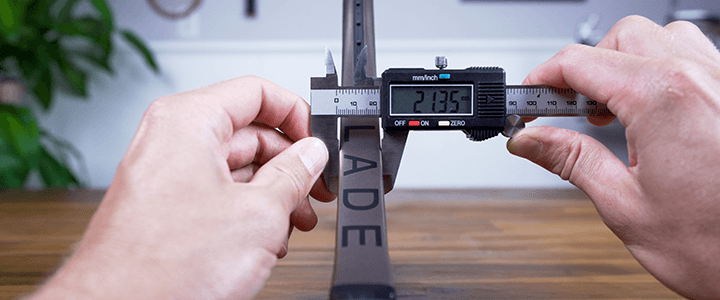
I created this guide for a broad range of player ages and levels. However, I’ve focused my energy on full-size tennis racquets at least 27 inches long, which is standard for adults.
Recognizing this, if you’re a parent looking for a kids’ racquet (typically geared toward children ages ten and under), I’d encourage you to jump over to my guide for kids’ tennis racquets as a starting point.
Furthermore, if you’re brand new to the sport, you may want to check out my racquet guide for beginners. There’s still plenty to learn in this guide, but that article will likely be an ideal starting point for you.
Why I Created This Guide

I’ve written a lot about tennis racquets to help players better understand the nuances of racquet specifications and performance, and the positive feedback about those resources humbles me.
However, many players still ask for my opinion and recommendations on my top picks, so I made it official and now keep a running list of my favorite tennis racquets yearly.
This guide will give you an overview of my picks for the best racquets on the market, but more importantly, I’ll do my best to provide you with a summary of the “why” behind each racquet’s selection and ranking.
In other words, I go beyond a simple list and dive deep into the attributes that make each racquet unique to bring you a practical guide to use as a jumping-off point for selecting a new tennis racquet.
With the help of this guide, I’d encourage you to narrow down 3 to 5 that appeal to you and then research them further. To that end, I’ve created dedicated reviews for many of the racquets already, and I’m diligently working on releasing new articles all the time.
Tips for Using This Guide

To help you get the most out of this resource, I’ve developed the following tips to consider while researching tennis racquets.
For extra advice, check out my guide on choosing a tennis racquet, which covers all the factors worthy of consideration.
Know the Types of Racquets
Tennis racquets typically fall into four categories or types of racquets:
- Power
- Control (players)
- Tweener
- Modern players
Each type of racquet has pros and cons but seeks to provide specific players with unique qualities to maximize their success on the court.
Various factors might influence the type of racquet best suited for your needs, including age, experience level, technique, and strength.
Here’s a table highlighting some of the differences.
| Type of Racquet | Experience Level |
| Power | Beginner |
| Control (aka Players) | Advanced |
| Tweener | Intermediate |
| Modern Players | Intermediate / Advanced |
Remember that the above table serves as a general guide to point players in the right direction, but there’s often quite a bit of overlap in terms of which racquet may be ideally suited for you.
Consider Your Style of Play
A player’s style (or the style they’d like to develop) can influence the type of racquet a player purchases. Consider the following two players:
- Player A: Scrappy baseliner who hits with a ton of topspin and runs down every single ball
- Player B: Serve-and-volleyer who hits a big serve and follows their shots into the net to close out the point quickly
As you might imagine, the tennis racquet that will work well for these players will likely differ, with each looking for specific characteristics that align with their game and help them perform their best.
Once you identify the style of play you prefer, you can look for racquets that perform well in the areas that matter most. For example, player B might look for a racquet with a smaller head size for optimal control and precision and a bit of extra weight for stability.
Luckily, we can evaluate each racquet across a consistent set of attributes, making comparison and narrowing down options easier. We’ll touch on those characteristics shortly in an upcoming section.
Helpful Tip
If you haven’t developed a specific style or preference, that’s not a problem. It’s not a requirement to select a racquet, but it can be a practical consideration when sifting through the options.
Keep Your Current Racquet in Mind
If you’re in the market for a new racquet, I always recommend you first take some time to consider what you like and dislike about your current racquet, as it will likely be your main point of comparison.
Start by jotting down what’s working and not working with your current racquet so you can use that information to help scout your next frame. For example, if you like the topspin for your current racquet but are looking for extra control and improved feel, you can use those data points to help guide your decision-making.
Furthermore, you can compare the specs of your existing racquet to the new racquet you’re considering. Here are a few examples of specs:
- Head Size
- String Pattern
- Weight
- Balance
- Swingweight
- Stiffness
I’d encourage you to avoid getting too hung up on specs because feel matters most, but they can serve as a valuable point of context to narrow your options.
It’s okay you don’t have a racquet for comparison. Keep reading for tips that will help guide you regardless.
Develop Your Own Opinion
I’ve done my best to keep my selection of tennis racquets as objective as possible, which should help point you in the right direction and narrow down a few options for further research and consideration.
However, there’s no substitute for developing your opinion by hitting with a racquet of interest and experiencing it firsthand. I recommend demoing at least two racquets before deciding on which one to buy so you have multiple reference points.
Many brands, online retailers, tennis clubs, and racquet shops offer demo programs, and it pays to take advantage of them. What you spend to demo is often applied to your purchase if you buy with them, so it’s a win-win situation.
On a related note, I’d encourage you to avoid the temptation of buying the racquet that your favorite player endorses. Although it may be a great fit, you’ll do much better if you take a step back, learn about the racquet they endorse, and compare it to available options before purchasing.
Of course, it’s okay if the racquet you end up with is the same as the one your favorite player endorses after doing your homework. However, skipping those steps is a recipe for disappointment.
Don’t Forget About the Strings
Strings significantly influence the performance of your racquet, and their importance grows as your skills improve. As an intermediate to an advanced player, you should pay close attention to the type of string you choose, the tension you string your racquet, and your stringing frequency.
Here are a few resources I’ve created to help you find the perfect tennis string set to accompany your new racquet.
- The Best Tennis Strings
- The Ultimate Guide to Polyester Strings
- A Comprehensive Guide to Multifilament Strings
- Tennis String Gauge and Its Impact on Performance
- How Often Should I Change or Replace My Tennis Racquet Strings?
Like finding a new racquet, experimentation is crucial to finding the right strings to help you perform your best. However, the above guides should help make selecting a set you’ll love more straightforward.
Helpful Tip
When learning how to play tennis as a beginner, your strings won’t matter much. Your emphasis in learning will be on the fundamentals and technique, and you won’t yet have developed a fine-tuned sense for the differences between various strings and tensions. That’s not to say your strings don’t matter as a beginner, but you shouldn’t worry too much about them either.
Your Grip Size Matters
Every time you purchase or upgrade your tennis racquet, it’s crucial to ensure you’re selecting the appropriate grip size. Doing so will provide comfort while helping reduce the risk of injury.
To help make it easy, I have a handy article that will walk you through exactly how to choose the perfect grip size. Check it out to learn more.
As a side note, keep in mind that not all grips by every manufacturer are created equal. Although there are general guidelines for grip sizes, factors like the shape or feel of a racquet’s butt cap will vary to some degree.
Once again, it pays to demo multiple frames to experience a given racquet’s feel firsthand.
Intermediate vs. Advanced Racquets

Players frequently ask me about the difference between intermediate and advanced racquets. The truth is, there is a crossover, and many racquets work well for both levels of play.
With that said, when comparing the two, advanced racquets will typically have the following attributes:
- Heavier weight
- Smaller head size
- Tighter string pattern
- Thinner beam
The good news is that every racquet on my list is an excellent option for intermediate and advanced players.
Furthermore, most of the racquets I recommend in this guide come in multiple versions with adjustments to some variables, optimizing performance for one of two groups.
Here’s an example:
- Yonex EZONE 98
- Yonex EZONE 98 Tour
Each racquet offers similar specs, but the Tour model has 12 grams of extra weight, is slightly more flexible with an RA rating of 62 vs. 64, and offers a slightly more head light balance.
Both racquets can work well for intermediate and advanced players. However, the EZONE Tour’s specs will generally skew toward an advanced player’s preferences.
When applicable, I list the various models for each racquet, so I’d encourage you to explore those if the racquet on this list doesn’t seem to align perfectly with your specific needs.
How I Compare Racquets
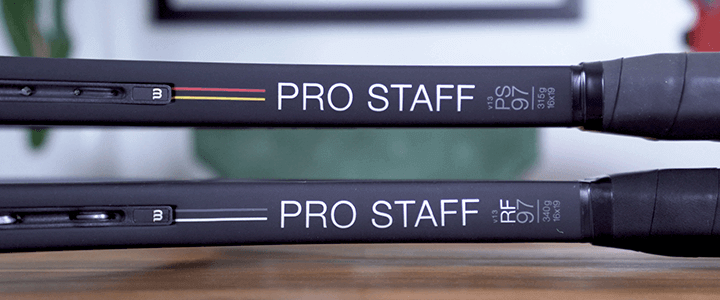
In my attempt to objectively select the top 25 tennis racquets on the market, I’ve evaluated each racquet across a consistent set of six attributes and strokes, which are helpful for comparison.
I played with each racquet and then rated its performance on a scale of 1-10 for each attribute and stroke. To calculate the overall score for a racquet, I took the average of the 12 scores.
Attributes
The following are the six attributes I used to evaluate each tennis racquet’s performance, which I have used for this list, along with descriptions, so you know what I mean by them.
Remember that your string selection will influence some of these attributes as you read through them.
Power
Experienced players can hit hard and generate power through proper technique regardless of the racquet you put in their hands. However, some racquets make generating pace significantly easier.
Powerful racquets tend to have larger head sizes and stiffer frames. In some cases, they’ll be longer by a half or three-quarters of an inch, referred to as extended length.
Control
Typically, the more experienced a player becomes, the more control they’ll seek from their racquet because precise placement or directing the ball exactly where they want it to go becomes increasingly important.
Furthermore, a more experienced player will have developed the technique and skill required to generate their own pace, so they don’t need to rely as heavily on the racquet to generate power.
With that in mind, control-oriented racquets often have thinner beams, less stiff frames, smaller head sizes, and tighter string patterns.
Comfort
Players often associate comfort with the shock sent to their arm when striking the ball or the vibration they feel after hitting it.
Comfort-oriented racquets tend to be a bit heavier and more flexible, and they focus additional weight toward the handle to help absorb shock.
However, it’s worth noting that a player might also associate comfort with the racquet’s weight relative to their strength, i.e., a racquet that’s too heavy will be uncomfortable.
Touch/Feel
Touch, or feel, is a bit nuanced and frequently tied to a sense of control and connectedness, especially when hitting volleys and finesse shots like drop shots. Racquets that provide enhanced touch tend to be heavier, have smaller head sizes, and use more flexible frames.
Some players prefer a stiffer, more responsive racquet, while others prefer a softer, more forgiving feel. One type of feel isn’t better than the other; it’s completely subjective.
Maneuverability
Easy-to-maneuver racquets tend to feel light in your hand and make it easy to change the racquet head’s direction.
Aside from a racquet’s static weight, i.e., its weight when placed on a scale, the feeling of maneuverability often results from its overall weight combined with the frame’s distribution of weight or balance.
Head light racquets, denoted as HL, apply more of the racquet’s weight toward its handle, helping make it feel easier to maneuver.
Stability
Stable tennis racquets remain steady when striking a ball and help instill a positive sense of consistency and accuracy. Often, stable racquets are heavier, have smaller heads, and have more flexible frames.
Tennis Shots
The following are the tennis shots I used to evaluate each tennis racquet. I won’t go into great detail here on each of these, but you can check out my article on the different types of tennis shots to learn more.
- Serves
- Volleys
- Returns
- Groundstrokes
- Topspin
- Slice
Hopefully, you now have a good sense of how I’ve evaluated my selection of the top 25 tennis racquets.
Racquet Specifications
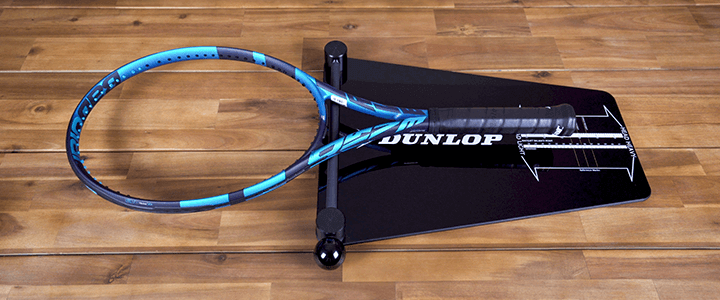
As you research and evaluate tennis racquets, you’ll likely encounter specifications or attributes that retailers showcase to help players compare racquets and decide on a good fit.
Although I’d encourage you to avoid getting too hung up on specs, they can serve as a valuable point of context to narrow your options, so here’s a brief overview of what each of them means.
- Head Size: The surface area of the racquet’s head where you’ll find the strings, expressed in square inches or centimeters.
- Length: A measure of a racquet from the bottom of the handle to the top of the head. Most racquets are 27 inches (69 cm), but you’ll sometimes find extended-length options that add anywhere between a half inch to an inch in length.
- String Pattern: Refers to the number of main (vertical) and cross (horizontal) strings. An open string pattern, e.g., 16×19, has fewer mains and crosses to enhance spin, while a closed string pattern, e.g., 18×20, has more mains and crosses to improve control.
- Weight: How heavy a racquet is, expressed as strung or unstrung.
- Balance: The distribution of weight throughout a frame expressed as a measurement from the racquet’s balance point to the end of the handle. A head heavy racquet has more weight distributed toward the head, while a head light racquet has more weight distributed toward the handle.
- Swingweight: How heavy a racquet feels when swinging as measured by a diagnostic machine. Higher numbers refer to a heavier swingweight, while lower numbers suggest a lighter swingweight.
- Stiffness: The amount a racquet flexes or bends when hitting a ball. The higher the rating, the stiffer the racquet, while the lower the rating, the more flexible the racquet.
- Beam Width: A measure of a racquet’s thickness at the throat, side of the head, and top of the head.
To explore these topics further, check out the following guides.
- Racquet head size and length
- Racquet weight, balance, and swingweight
- Racquet stiffness
- Racquet string patterns
Ultimately, specs don’t tell the whole story, which is one of the reasons I’m adamant about encouraging players to demo racquets before buying, to gain first-hand insight and feel.
What’s the Best Tennis Racquet for 2024?
In 2024, and for the seventh year in a row, I’m naming the Babolat Pure Strike 16×19 the best overall tennis racquet despite some notable new frame releases and more than 300 total on the market today.
Babolat Pure Strike 16×19
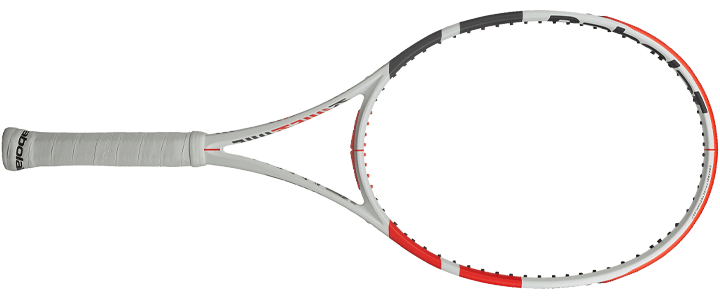
In 2017, there were a few key reasons that the Pure Strike won me over to earn my badge as the best tennis racquet, and that logic remains consistent in 2024 with Babolat’s 3rd generation of this racquet.
As we’ve stated in the past, the Pure Strike’s defining feature and what sets it apart from many other racquets is its broad appeal to a wide range of styles and levels of play. Its 11.4 oz strung weight and 98 in² head size make it a very approachable tennis racquet.
In other words, most players would pick up this racquet and enjoy the frame’s performance, as it scores well across the board. You could flip that statement and say that this racquet is unlikely to offend anyone.
Players who will likely enjoy Babolat’s Pure Strike are all-court players who like to attack the net and are looking for a well-balanced tennis racquet that performs consistently across a wide range of attributes and strokes.
Technologies
Babolat’s Pure Strike makes use of a few key technologies.
Woofer
The frame’s design allows the strings to move freely so that they can work together for a more generous sweet spot, additional power, and less shock.
Hybrid Frame Construction
The frame uses square and elliptical shapes in strategic locations to offer a unique blend of control and power that is highly responsive with excellent feel and precision.
FSI Power
Babolat Pure Strike also uses the company’s FSI Power technology, increasing the cross strings’ spacing. The result is more power, spin, and comfort when striking the ball.
C2 Pure Feel
New to the 3rd generation of this racquet is a thin rubber material applied to the frame at three and nine o’clock to give the racquet a softer, more dampened feel.
Why I Love It
Here’s a look at the Pure Strike’s top three attributes based on how the racquet scored in my evaluation.
Maneuverability
At 11.4 ounces and clocking in a swingweight of 327, the Pure Strike is delightfully easy to maneuver, which makes bringing the racquet back for groundstrokes effortless and transitioning to the net to hit a setup volley loads of fun.
Groundstrokes
Off the ground, the Pure Strike is a delight. The frame delivered plenty of power along with its 98 in² head, while its 16×19 string pattern helped produce fantastic spin. Simultaneously, everything felt under control, supported by a slightly more flexible frame than some of the other racquets in the Babolat family.
Returns
With a strong rating on groundstrokes, it should be no surprise that this highly maneuverable racquet delivered fantastic performance when hitting returns, where you must react quickly and pull back your racquet fast. However, the Pure Stike is unique because it maintains its high marks at the net with volleys.
Ultimately, the Pure Stike is unique because it maintains its high marks up at the net with volleys.
Tradeoffs
Overall, the Babolat Pure Strike left me feeling pleased across the board. However, it may leave some players longing for a bit more in specific performance areas. In particular, baseline players who hit with heavy topspin may prefer more pop.
However, the slightly lower power delivered by the Pure Strike is offset by the precision, control, and touch that it offers to ensure it performs consistently, no matter where you’re playing on the court.
Specs
| Head Size | 98 in² / 632.26 cm² |
| Length | 27 in / 68.58 cm |
| Balance | 4 points HL |
| Weight (strung) | 11.4 oz / 323 g |
| Swingweight | 327 |
| Stiffness | 66 |
| Beam Width | 21mm / 23mm / 21mm |
| String Pattern | 16 Main / 19 Cross |
Ratings
Variations
If you like what you see with the Pure Strike, you should check out some of the different racquets in the Pure Strike series. Here’s a list for quick reference:
- 98 16×19
- 98 18×20
- 100
- Tour
- Team
- EVO
Players Using or Endorsing
- Dominic Thiem
- Anett Kontaveit
- Timea Bacsinszky
- Alize Cornet
- Elena Vesnina
- Mirjana Lucic-Baroni
- Thanasi Kokkinakis
Head Speed MP
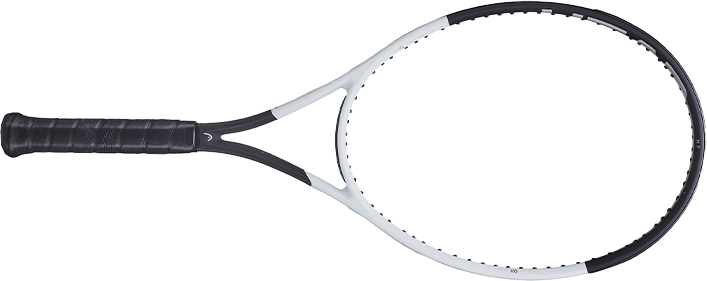
The Head Speed MP 2024 is the latest evolution of a popular racquet from Head, endorsed by players on the ATP and WTA tour, including Jannik Sinner, Bianca Andreescu, Karolina Muchova, Bethanie Mattek-Sands, and many more.
As you might expect, this frame delivers excellent performance from the baseline, allowing big groundstrokes with heavy topspin and exceptional maneuverability on returns.
One of this racquet’s key features is Graphene 360+ (also called Graphene Inside), a lightweight and robust nanomaterial. You can think of it as traditional graphite on steroids. The latest evolution of this technology incorporates SpiralFibers in the lower portion of the racquet’s head for optimal flex, contributing to the frame’s lower stiffness rating of 60.
Graphene also reduces the racquet’s weight through the frame’s midsection, allowing Head to redistribute that weight to produce a fast-swinging racquet that’s light and maneuverable.
New for 2024, Head improves the racquet’s feel and response by introducing Auxetic 2, a unique construction for the yolk’s layup, contributing to a slightly more muted feel as the tech also helps reduce vibration. If you’re unfamiliar, the yolk is the bottom portion of the racquet’s head that bridges the top of the racquet’s throat.
The Head Speed MP has a 100 in² head and 16×19 string pattern consistent with past models. The larger head size helps provide a more prominent sweet spot and increases power, while the open string pattern allows players to remain in control with plenty of topspin.
The racquet feels light at the net and provides a stable, crisp response that allows for accurate placement, which makes the frame an excellent choice for players with an all-court style of play.
Overall, the Head Speed MP 2024 is a fast-swinging and easy-to-maneuver frame that allows for aggressive play with plenty of topspin from the back of the court.
Why I Love It
Here are my top three reasons why the Head Speed MP 2024 makes my list of the best racquets for 2024.
Groundstrokes
One of the first things you’ll notice is that the Head Speed MP feels great in your hand. At 11.1 ounces, it feels solid, but with its 4-point head light balance, it swings effortlessly.
This weight and balance blend nicely for a tennis racquet that allows you to accelerate quickly through contact and take significant cuts at the ball from the baseline while maintaining control through topspin.
Returns
Everything I loved about the Speed MP hitting groundstrokes translated perfectly to my returns, and the easy maneuverability came in handy. I felt I could be aggressive and step into my shots even when my opponent turned up the heat.
Control
While there is enough pop to this frame, you’ll still rely on your technique and racquet acceleration to generate maximum power. Ultimately, this keeps you in the driver’s seat, allowing you to swing confidently and precisely hit your spots.
Tradeoffs
One area where racquets in this class often suffer is stability, and it’s most definitely an area this racquet could improve, primarily a function of its moderate weight. However, this is a marginal issue for a frame offering such a balanced performance.
Note: Players looking to enhance the frame’s stability might consider adding a bit of lead tape at 10 and 2 o’clock.
Specs
| Head Size | 100 in² / 645.16 cm² |
| Length | 27 in / 68.58 cm |
| Balance | 4 points HL |
| Weight (strung) | 11.1 oz / 315 g |
| Swingweight | 330 |
| Stiffness | 60 |
| Beam Width | 23mm / 23mm / 23mm |
| String Pattern | 16 Main / 19 Cross |
Ratings
Variations
- Speed Pro
- Speed MP
- Speed MP Lite
- Speed Team
- Speed PWR
Players Endorsing the Speed Line
- Novak Djokovic
- Fernando Verdasco
- Jannik Sinner
- Mischa Zverev
- Nikoloz Basilashvili
- Bianca Andreescu
- Karolina Muchova
- Cori (Coco) Gauff
- Elise Mertens
- Samantha Stosur
- Monic Puig
Babolat Pure Aero 2023
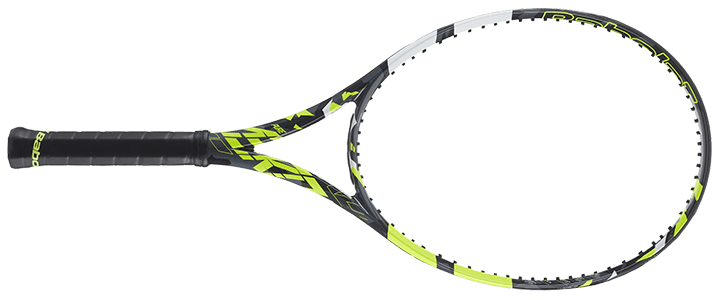
Next on the list is the Babolat Pure Aero, made famous by clay court king Rafael Nadal. Undoubtedly, the racquet’s defining features center around its ability to generate topspin.
For the latest update, the Babolat Pure Aero received a few minor tweaks, including a slight reduction in stiffness for improved comfort and a minor tweak to the frame’s string spacing.
To reduce the racquet’s stiffness from 67 to 65 compared to the prior 2019 model, Babolat added its NF² technology, which incorporates flax (yes, like the plant) into the racquet’s handle and the upper portion of the racquet’s head to absorb shock for a more comfortable response.
I enjoy hitting with this updated frame that feels less harsh than the last model. Of course, an update to a tennis racquet wouldn’t be complete without a fresh paint job, and for this version, Babolat has moved away from the muted all-yellow cosmetic to a black frame with neon yellow highlights.
As it had in the past, the Pure Aero features an open 16×19 string pattern and FSI Spin technology. However, Babolat also modified the formula by opting for tighter string spacing to improve control while maintaining the freedom of movement within the grommets for optimal spin.
Combine those features with Babolat’s Woofer Technology, a 100 in² head size, and lower flex, and you get power on top of topspin – an excellent combination for the modern baseline game.
True to its name, the Babolat Pure Aero also features Babolat’s Aeromodular 3 frame design, which varies the frame’s shape and form factor at critical parts of the racquet for an aerodynamic profile that allows the racquet to swing quickly through the air.
As you can imagine, players who love to hit with topspin and grind out points from the baseline are an excellent fit for the racquet.
Why I Love It
Here’s a look at the Babolat Pure Aero’s top three attributes based on how the racquet scored in my evaluation.
Topspin
Without a doubt, the Pure Aero’s defining characteristic is topspin. The aerodynamic frame, mid-range weight, and head light balance make it easy to swing, helping me generate increased racquet speed and leaving me feeling like I didn’t have to work as hard to produce spin. Players looking to get the most out of this frame in this category should consider a polyester string if comfort isn’t an issue.
Power
Next up, this racquet performed very well when it came to power. Overall, the Pure Aero packs a punch and delivers easy access to pace when you need it, which pairs well with the frame’s heavy topspin.
Groundstrokes
I found fantastic performance with the Babolat Pure Aero at the baseline through the combination of power and topspin. Again, it felt comfortable and easy to swing, and the heavier ball I could hit helped to keep my opponents on their toes.
Tradeoffs
While the Pure Aero excels off the ground, it did leave a bit to desire as I transitioned to the net. The racquet’s stiffer frame and higher power required extra care and focus at the net. While it certainly gets the job done, it might not be the first pick for players who like to move forward and close out points quickly.
In the past, I’ve mentioned that while the racquet felt reasonably comfortable to hit with, players suffering from arm injuries or tennis elbow will likely find it a bit harsh on the arm. Despite receiving a few tweaks to lower the racquet’s stiffness this year, I recommend players look elsewhere if comfort is a top priority.
Specs
| Head Size | 100 in² / 645.16 cm² |
| Length | 27 in / 68.58 cm |
| Balance | 4 points HL |
| Weight (strung) | 11.2 oz / 318 g |
| Swingweight | 322 |
| Stiffness | 65 |
| Beam Width | 23mm / 26mm / 23mm |
| String Pattern | 16 Main / 19 Cross |
Ratings
Variations
If the Babolat Pure Aero looks like the racquet for you, check out the other variations on this tennis racquet. Here’s a list:
- VS
- 2019
- Tour 2019
- Plus 2019
- Lite 2019
- Team 2019
- Play
- Roland Garros
Players Using or Endorsing
- Rafael Nadal
- Catherine (Cici) Bellis
- Jennifer Brady
- Danielle Collins
- Benoit Paire
- Jo-Wilfried Tsonga
- Sam Querrey
- Felix Auger-Aliassime
- Caroline Wozniacki
- Bethanie Mattek-Sands
- Jack Sock
- Johanna Konta
- Marco Cecchinato
Wilson Pro Staff 97
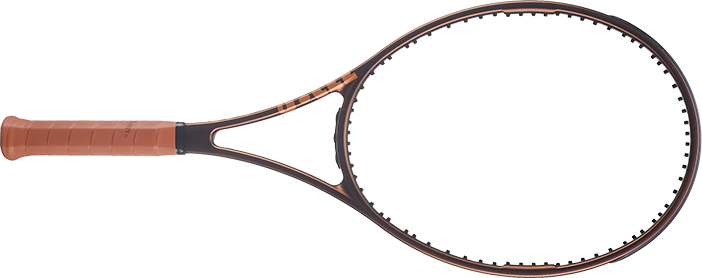
Long-awaited Pro Staff fans welcomed the Pro Staff 97 v14 in 2023, with Wilson continuing to emphasize unique technologies aimed at the racquet’s bending characteristics.
As the name suggests, this racquet has a 97 in² head and an open 16×19 string pattern. Its weight is a hefty 11.7 ounces, but with a 7 pt head light balance, it retains its maneuverability and a reasonable swingweight of 325. The thin beam is 21.5 mm all the way around for optimal precision and control.
The fourteenth generation of the Pro Staff continues using FourtyFive, Wilson’s update to their classic braided graphite and Kevlar construction, which changes the weave’s angle to 45 degrees for improved feel and ball pocketing.
However, in the latest model, Wilson integrates Paradigm Bending, a unique layup from the frame’s shaft to the hoop to enhance flex for a more classic feel.
The racquet also continues to use Wilson’s String Mapping Tech for added control, which tightens the center mains for a more dense string bed and sweet spot to improve control and feel. However, since the racquet retains its 16×19 string pattern, it still offers ample spin.
Finally, as you’d expect from a Pro Staff, the racquet features Wilson’s Perimeter Weighting System at three and nine o’clock to improve stability by reducing the twisting at impact.
Why I Love It
Here are the top three reasons I enjoy playing with the Pro Staff 97.
Control
Over the years, precision and control have remained a defining characteristic of the Pro Staff family of racquets, and the Pro Staff 97 v14 is no exception. Add exceptional stability, and the Pro Staff 97 is a top-notch frame for all-court play.
Touch & Feel
At the net, the racquet performs exceptionally well. Along with its great control, I also love the racquet’s connected feel, excellent feedback, and response. The combined result is added confidence and precision regardless of the shot you’re hitting.
Maneuverability
Pro Staff models have always maintained terrific maneuverability even with their heavier weight due to their head light balance. For the Pro Staff 97 v14, this is particularly useful for generating the racquet head speed necessary for topspin and quickly getting the racquet into position on returns.
Tradeoffs
The Wilson Pro Staff 97’s design and characteristics set out to deliver maximum control and precision, so it’s no surprise it doesn’t offer much free power, which means the player is responsible for generating pace when needed. Of course, this is the formula many intermediates to advanced players seek.
Despite the frame delivering plenty of topspin, it lacks in this department relative to other spin machines on our list but will work well for players who prefer to flatten the ball out.
Specs
| Head Size | 97 in² / 625.81 cm² |
| Length | 27 in / 68.58 cm |
| Balance | 7 points HL |
| Weight (strung) | 11.7 oz / 332 g |
| Swingweight | 325 |
| Stiffness | 66 |
| Beam Width | 21.5mm / 21.5mm / 21.5mm |
| String Pattern | 16 Main / 19 Cross |
Ratings
Variations
- RF97
- 97
- 97L
- 97UL
- X
- Six.One 100
- Team
- 26 Junior
Players Endorsing the Pro Staff Line
- Roger Federer
- Roberto Bautista Agut
- Juan Martin del Potro
- Grigor Dimitrov
- Ons Jabeur
- Petra Kvitova
- Kyle Edmund
- Philipp Kohlschreiber
- Reilly Opelka
Yonex EZONE 98 2022

In 2022, Yonex released an exceptional update to their popular EZONE 98. Although minor, I’m enjoying the changes they made, and it continues to win me over with its versatility, broad appeal, and exceptional performance from all areas of the court.
Of course, no tennis racquet is perfect, but the Yonex EZONE 98 delivers an incredibly balanced performance that will work well for a wide range of tennis players, and its downsides are minimal.
It’s well-suited for all-court play and performs well across the board, making it an incredibly versatile racquet that instills confidence.
Yonex racquets’ Isometric or square-shaped design increases the sweet spot’s size by 7% compared to the traditional oval shape, which is an excellent feature for a smaller 98 in² head.
Most racquets have their grommets drilled at an angle that matches the arc of the racquet’s head. However, with the latest EZONE 98, Yonex maintains its Linear Tech Grommet System with several grommet holes drilled straight through to improve the racquet’s power and comfort.
Another change for the racquet’s head is the updated aero shape design at the top of the hoop that’s thinner than the prior generation, which helps improve feel for a more forgiving response.
The materials integrated into a racquet’s throat can dramatically impact its performance, so Yonex has introduced an updated carbon fiber called 2G-Namd Speed for optimal feel and flex for controllable power. They’ve also adjusted the shaft design just above the handle for better stability and a slight improvement in power.
Like the previous generation, the EZONE 98 maintains its Oval-Pressed Shaft. By rounding the corners of this section of the frame, Yonex seeks to deliver ideal flex while enhancing dwell time for better control and spin.
You’ll also find the 2022 version of the EZONE 98 features Yonex’s Vibration Dampening Mesh in the handle to reduce vibration and subsequently improve comfort and feel.
Another reason the EZONE line of racquets stands out is the depth of the offering from Yonex, with over 15 models available. As a result, players who are intrigued by this racquet have plenty of options to consider.
Why I Love It
Based on how the Yonex EZONE 98 scored in my evaluation, here’s a recap of its top attributes.
Control
With a smaller 98 in² and a moderate stiffness rating of 65, the EZONE 98 delivers great control without completely giving up on the power front, especially when combined with a stiffer poly.
Groundstrokes
The Yonex EZONE 98 is a fun and effortless racquet to hit with from the back of the court. It swings easily to help deliver added topspin and helps maintain precision while offering excellent response and added pace when you’re in a position to attack.
Touch
Whether hitting groundstrokes, volleying up at the net, serving, or returning serve, the EZONE 98’s moderate 11.4oz weight and 6pt HL balance when strung make it easy to maneuver and quickly get the racquet into position.
Tradeoffs
At times, I felt the racquet could use a bit of added stability. However, this is likely only something advanced players would notice facing players who hit with extra pace. Plus, it’s easy to adjust the racquet with some customization for those players needing it.
For the most part, the Yonex EZONE 98’s balanced performance left me satisfied. As a result, the most significant tradeoff you make with this racquet is that it won’t deliver maximum performance in any specific area, such as spin or control. For many, that’s perfectly suitable.
Specs
| Head Size | 98 in² / 632.26 cm² |
| Length | 27 in / 68.58 cm |
| Balance | 6 points HL |
| Weight (strung) | 11.4 oz / 323 g |
| Swingweight | 318 |
| Stiffness | 65 |
| Beam Width | 23.5mm / 24.5mm / 19.5mm |
| String Pattern | 16 Main / 19 Cross |
Ratings
Variations
If you’re interested in the Yonex EZONE 98 but are unsure if it’s an ideal fit, check out a few of the available EZONE models. Here’s a quick snapshot of your options.
- 97 Tour
- 98L
- 98+
- 100
- 100L
- 100+
- 100SL
- 105
- 108
- Game
- Ace
- Feel
Players Using or Endorsing
- Nick Kyrgios
- Naomi Osaka
- Steve Johnson
- Anastasija Sevastova
- Coco Vandeweghe
- Laura Siegemund
Head Gravity Pro
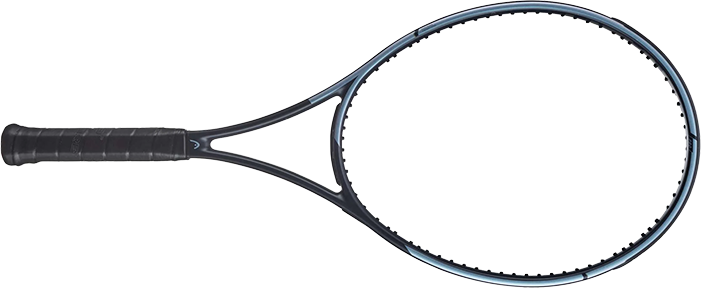
The Head Gravity Pro 2023 is heaviest members of Head family of tennis racquets delivering control, stability, and comfort.
A handful of specs coalesce to provide players with maximum control, including its thin 20 mm beam, tighter 18×20 string pattern, heavier 11.7-ounce strung weight, and low 63 stiffness rating. Ultimately, it’s ideal for experienced players looking to generate their own pace.
Unique to Gravity Pro is Graphene 360+, which combines Head’s specialized graphite formula with unique SpiralFibers in the racquet’s construction at the bottom of the head to increase the frame’s flex and return energy to the ball for a responsive feel.
New for 2023, Head adds their Auxetic construction to the layup of the racquet’s throat for improved feel, response, and vibration dampening, which I’ve found to be a welcome addition.
The Gravity Pro is a fantastic racquet that will please a specific crowd of players with the strength and confidence to wield it.
Why I Love It
Here are the top three reasons I enjoyed hitting with the Head Gravity Pro 2023.
Control
Everything about this racquet caters to precision, and it shows everywhere on the court. Whether I was hitting groundstrokes, returns, or volleys, I felt like I could hit my spots with confidence.
Stability
Weighing in at 11.7 ounces strung, the Gravity Pro isn’t easy to push around. I felt like I could easily absorb and deal with pace from the back of the court, and the same was true when hitting returns and volleys.
Comfort
The racquet’s weight, head light balance, and super low 63 stiffness rating combine to give players tons of feel and make for an incredibly comfortable hitting experience with the frame absorbing shock.
Tradeoffs
With a control-oriented player’s racquet like the Head Gravity Pro, it’s no surprise you’re giving up power and maneuverability. It’s merely the tradeoff you make when you invest in this type of racquet.
Specs
| Head Size | 100 in² / 645.16 cm² |
| Length | 27 in / 68.58 cm |
| Balance | 6 points HL |
| Weight (strung) | 11.7 oz / 332 g |
| Swingweight | 334 |
| Stiffness | 63 |
| Beam Width | 20mm / 20mm / 20mm |
| String Pattern | 18 Main / 20 Cross |
Ratings
Variations
- MP
- Team
Players Endorsing the Gravity Line
- Alexander Zverev
- Andrey Rublev
- Bethanie Mattek-Sands
Wilson Blade 98 18×20 v8
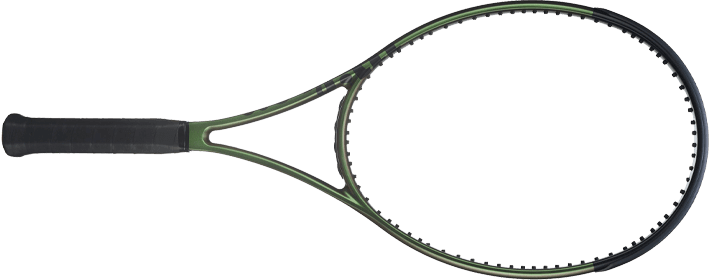
Over the years, the Wilson Blade has undergone more than a handful of transformations. However, at its core, the Wilson Blade remains a control-oriented player’s racquet that weighs a reasonable 11.4 ounces – the same weight as the prior generation.
Technologies include braided graphite and basalt construction, which increases the racquet’s flex, improves feel, and delivers more control. Basalt is a volcanic rock that manufacturers can use to produce fibers with characteristics similar to fiberglass.
In addition to the racquet’s unique composition, the racquet now uses Wilson’s new FortyFive technology, a rebrand of what was previously called FeelFlex in the prior generation. FortyFive enhances the frame’s vertical and horizontal flex to complement the modern swing path without giving up stability. As a result, the frame’s RA or flex rating drops to 61, which is one point less than the previous model.
The Wilson Blade 98 18×20 v8 also takes advantage of parallel drilling, i.e., drilling specific grommet holes parallel independent of the frame’s arc. Wilson claims up to a 27% increase in the sweet spot by taking this approach, which is a welcome addition to the frame, considering its smaller head size.
Wilson adds their new DirectConnect handle, which fuses that racquet’s butt cap with the handle’s carbon fiber to improve stability. However, despite the change, the racquet retains its top grip taper handle design for improved feel when hitting a two-handed backhand and its red ergonomic butt cap for comfort.
Finally, Wilson strays from their standard color scheme used across many of their racquet lines and uses a dynamic chameleon-style paint job that shifts colors depending on the light.
Why I Love It
Here are my top three reasons for loving this frame.
Control
The Wilson Blade’s slightly smaller 98 square inch head size, tighter 18×20 string pattern, stable 11.4-ounce weight, and low 60 stiffness rating combine to deliver solid control from all areas of the court.
Stability
Wilson’s strategic use of materials produces a stable frame and helps ensure consistent and reliable contact with the tennis ball for an authentic feel of a classic player’s racquet.
Comfort
The Wilson Blade 18×20 also delivers comfort, balancing material construction, weight, and flex rating. Overall, the racquet has a dampened, low-vibration feel, making for a pleasant and comfortable hitting experience.
Tradeoffs
While the Wilson Blade offers a respectable level of power, some players may find it more challenging to access higher levels of topspin with its tighter 18×20 string pattern. Of course, the topspin potential is there, but you’ll need to work harder for it.
Specs
| Head Size | 98 in² / 632.26 cm² |
| Length | 27 in / 68.58 cm |
| Balance | 4 points HL |
| Weight (strung) | 11.4 oz / 323 g |
| Swingweight | 327 |
| Stiffness | 60 |
| Beam Width | 21mm / 21mm / 21mm |
| String Pattern | 18 Main / 20 Cross |
Ratings
Variations
- 98 16×19 v8
- 98 18×20 v8
- 100L v8
- 100 v8
- 104 v8
- SW102 Autograph
Players Using or Endorsing
- Stefanos Tsitsipas
- David Goffin
- Milos Raonic
- Alex de Minaur
- Damir Dzumhur
- Karen Khachanov
- Pablo Carreno Busta
- Serena Willams
- Simona Halep
- Kiki Bertens
- Elina Svitolina
- Lauren Davis
- Jelena Ostapenko
- Barbora Strycova
Babolat Pure Drive 2021
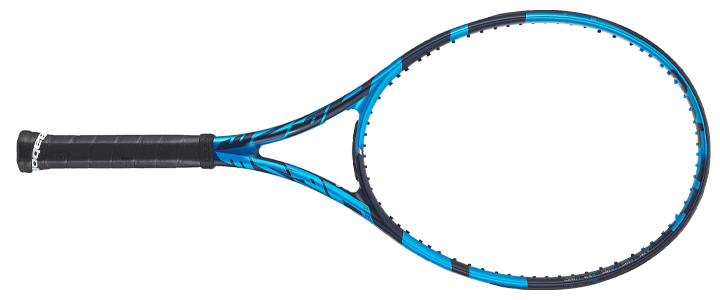
Over the years, the Babolat Pure Drive has become an iconic tennis racquet backed by some of the game’s top players, including Andy Roddick before retiring and, more recently, Garbine Muguruza.
Relaunched in September 2020, the Babolat Pure Drive 2021 doesn’t veer too far from the prior generation, with a handful of iterative tweaks that remain true to this ever-popular frame.
A high power level and easy access to topspin define the Pure Drive, making it a fantastic choice for baseline tennis players and big servers. It’s also a very approachable racquet for beginners, combined with its 100 in² head and 11.2-ounce strung weight.
If you’re just getting started with tennis and like what you see, but the price feels too steep, check out my list of the best beginner racquets. My top pick is the younger sibling to this racquet, the Babolat Boost Drive.
Of course, the Babolat Pure Drive comes loaded with various features to help you perform your best on the court. Babolat’s FSI technology combines its time-tested woofer system that increases power and the sweet spot’s size by allowing the strings to work together, while a tighter string pattern within the sweet spot aids in control.
The racquet’s elliptical geometric design reduces flex and increases the frame’s overall rigidity, further aiding in power. Babolat also used its carbon-fiber GT technology in the head for added strength.
For 2021, Babolat introduces their HTR System, enhancing the hoop’s graphite to strengthen and improve the frame’s rigidity, which results in improved energy transfer and enhanced power.
Finally, the Pure Drive takes its Pure Feel technology (a thin layer of rubber within the graphite) further by increasing its coverage within the shaft to improve its feel.
Why I Love It
There’s a lot to love about the Babolat Pure Drive, as it’s been one of my favorites for years, but here are my top three reasons.
Power
First and foremost, I love the Pure Drive’s ability to help generate power without breaking a sweat. The 100 in² head provides a generous sweet spot, and the lighter 11.2-ounce strung weight makes it easy to swing. There’s no need to muscle this racquet to generate pace. It delivers pace efficiently and makes for a fun racquet off the baseline.
Spin
With all that power, the good news is that the Babolat Pure Drive also provides excellent access to topspin to help control your shots and keep the ball in the court. Again, the frame’s 100 in² head and 16×19 string pattern help deliver that topspin, which I found came easily and helped me keep my opponent on their toes.
Serves
I love serving with the Babolat Pure Drive – it’s one of the best in this arena. I could easily generate the pace I desired on my first serve and found that my kick serves received some added pop that helped keep it out of my opponent’s strike zone.
Tradeoffs
Players who enjoy a heavier, control-oriented tennis racquet will likely find the lower weight and higher power associated with the Pure Drive to be overbearing. Of course, those same characteristics make it perfect for other players.
One thing to remember is that Pure Drive is one of the stiffest frames on the market, so players with tennis elbow should carefully consider that before purchasing this racquet.
Specs
| Head Size | 100 in² / 645.16 cm² |
| Length | 27 in / 68.58 cm |
| Balance | 4 points HL |
| Weight (strung) | 11.2 oz / 317.51 g |
| Swingweight | 320 |
| Stiffness | 71 |
| Beam Width | 23mm / 26mm / 23mm |
| String Pattern | 16 Main / 19 Cross |
Ratings
Variations
- Plus
- Tour
- Tour Plus
- Team
- Lite
- 107
- 110
- Wimbledon
- Play
Players Using or Endorsing
- Fabio Fognini
- Lucas Pouille
- Karolina Pliskova
- Amanda Anisimova
- Julia Goerges
- Sofia Kenin
- Garbine Muguruza
- Dominika Cibulkova
Wilson Clash 100 v2
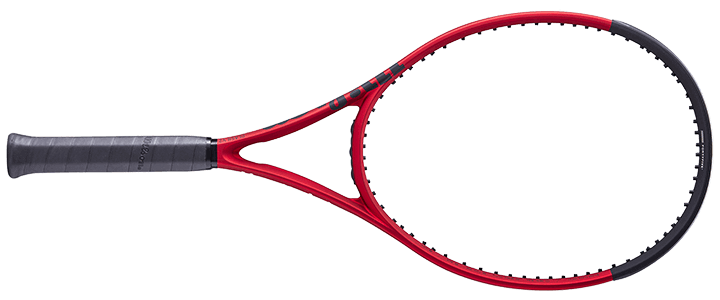
The Wilson Clash 100 v2 is an arm-friendly tennis racquet that delivers a well-rounded performance and practical improvements over the prior generation.
The Clash features a forgiving 100 in² head size, an open 16×19 string pattern, and a 24.5 mm flat beam for moderate power and plenty of access to topspin. New for 2022, Wilson reconstructs the tip of the racquet’s hoop to aid consistency and enhance the sweet spot.
For comfort, the racquet integrates FortyFive and StableSmart. FortyFive is a specialized graphite layup that enables above-average horizontal and vertical flex. At the same time, StableSmart takes the form of a unique geometry applied to the frame’s throat, ensuring stability on contact and helping the racquet retain power.
The Clash 100 has a manageable 10.9-ounce weight and a 7-pt HL balance. As a result, it’s a fast-swinging racquet, a crucial attribute for players looking to enhance topspin.
This racquet is an excellent option, especially for intermediate players who have struggled with arm discomfort. Advanced players will likely find the Wilson Clash 98 v2 or Clash 100 Pro v2 appealing. However, higher-level players who enjoy customizing their racquet’s specs might opt for this model, which provides more room for adding weight.
Why I Love It
Here are the three reasons I love the latest addition to Wilson’s line of performance tennis racquets.
Comfort
With its incredibly low stiffness rating of 55, the Wilson Clash is one of the most arm-friendly racquets on the market. At first, the unique feel takes a little time to adjust, but you quickly start to appreciate the difference, especially if you’re coming from a stiffer frame.
Maneuverability
The Clash 100 weighs only 10.9 ounces strung, with a 7-point head light balance. The result is an easy-to-swing and highly maneuverable racquet, which I enjoyed on returns and up at the net.
Spin
With its 100 in² head, open 16×19 string pattern, and head light balance, the Clash swings fast and allows you to generate tons of topspin. As a result, it’s a strong performer from the baseline.
Tradeoffs
While the racquet’s construction goes a long way to help it maintain stability on contact, I still found a desire for a bit more control. I could compensate with extra topspin to a degree, but it’s worth noting if considering this racquet.
Specs
| Head Size | 100 in² / 645.16 cm² |
| Length | 27 in / 68.58 cm |
| Balance | 7 points HL |
| Weight (strung) | 10.9 oz / 309 g |
| Swingweight | 312 |
| Stiffness | 55 |
| Beam Width | 24.5mm / 24.5mm / 24.5mm |
| String Pattern | 16 Main / 19 Cross |
Ratings
Variations
- 98
- 100
- 100 Tour
- 100L
- 100UL
- 108
Players Using or Endorsing
- Nicole Gibbs
Yonex Percept 97
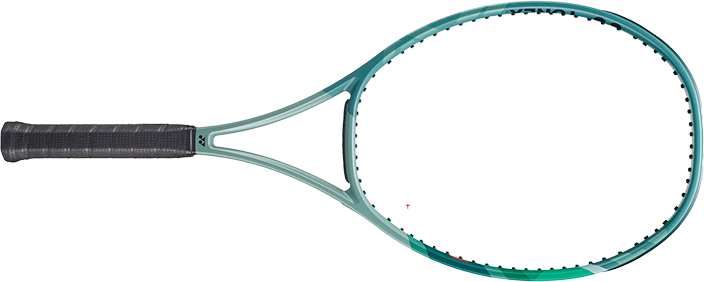
Replacing the VCORE Pro 97, the Yonex Percept 97 remains a top pick for intermediate to advanced players, with minimal modifications to the formula players love.
The Yonex Percept 97 is a well-balanced tennis racquet that delivers across the board as an excellent option for all-court players who love to hang out on the baseline, enjoy moving around the court, and those who come to the net.
Overall, the Percept 97 will suit a broad range of players looking for control without the extreme weight that often comes with control-oriented tennis racquets. Its specs – a weight of 11.5 ounces, a 97 in² head, and a 7-point head light balance – remain identical to its predecessor for an easy-to-maneuver package, tour-level control, and plenty of power.
Of course, coming from Yonex, this racquet doesn’t skimp on unique technologies to deliver an excellent hitting experience. With this update, Yonex revises the racquet’s throat geometry by adding 2G-NAMD Flex Force graphite to improve flex, ball pocketing, and the potential for topspin. In addition, Yonex adds a shock-absorbing polymer to the racquet’s shaft called Servo Filter to reduce vibration for comfort.
As expected, the head features the company’s signature Isometric square head shape, which increases the sweet spot’s size. Yonex also introduces its Flexcon System, which elongates the throat and shaft with a distinct taper that enhances flex for improved dwell time.
Complementing the more flexible shaft and throat, the Yonex Percept has a stiffer racquet face by adding extra graphite layers to enhance stability for a consistent response.
Why I Love It
My top three reasons for loving the Yonex Percept 97 include control, groundstrokes, and touch/feel.
Control
The Percept 97 is yet another fantastic control-oriented tennis racquet, which is unique in that it offers a high level of control without giving up too much power or weighing too much. A 7-point headlight balance translates into a maneuverable racquet that’s easy to swing and generates racquet head speed for reliable and well-placed groundstrokes.
Groundstrokes
Overall, I had the most fun with this racquet at the baseline, where I found terrific placement and the confidence to go for my shots while hitting my targets. I also enjoyed my backhand slice, which felt solid. The frame is also stable, allowing me to move the racquet head through the ball for a crisp shot.
Touch/Feel
Even with its lower 11.5-ounce weight, the Percept 97 delivered excellent feel off the ground and played well up at the net, where volleys felt crisp and under control.
Tradeoffs
Not surprisingly, the most significant tradeoff with the Yonex Percept 97 is easy-to-access power. As with most control-oriented racquets, the frame consists of features that, first and foremost, support accuracy and precision. However, the good news is that it doesn’t give up power like other control-oriented tennis racquets.
Specs
| Head Size | 97 in² / 625.81 cm² |
| Length | 27 in / 68.58 cm |
| Balance | 7 points HL |
| Weight (strung) | 11.5 oz / 326 g |
| Swingweight | 315 |
| Stiffness | 60 |
| Beam Width | 21mm / 21mm / 21mm |
| String Pattern | 16 Main / 19 Cross |
Ratings
Variations
- 97
- 97L
- 97D
- 97H
- 100
- 100L
- 100D
- Game
Players Endorsing the Percept Line
- Frances Tiafoe
- Stanislas Wawrinka
- Hubert Hurkacz
- Hyeon Chung
- Marcos Giron
- Pierre-Hugues Herbert
- Thomas Martin Etcheverry
Yonex VCORE 98 2023

For 2024, the VCORE 98 makes my list, and I’m super excited about what the updated racquet brings to the table while still delivering the same speed and spin I loved in the prior model.
As with all Yonex models, it features an Isometric head shape to increase the sweet spot by 7% compared with typical rounded frames. However, Yonex also refines its drilling of the holes for the outer main strings with its Linear Tech to widen the sweet spot and enhance string movement.
New for the latest release, Yonex has enlarged the frame’s top at 2 and 10 o’clock to expand the surface area when hitting while raising the ball’s launch angle, resulting in added depth of shot for players.
The racquet also comes built for speed. Its relatively thin beam, 6-point head light balance, and integrated Aero Fin technology at the top of the frame’s head and just above the racquet’s throat reduce air resistance and subsequently help players improve racquet head speed.
Of course, Yonex didn’t stop there. The racquet incorporates their Aero Trench grommet system for the main strings at the top of the racquet’s head, hiding the grommets and decreasing air resistance, resulting in even faster swings to generate more topspin.
For materials, the VCORE 98 (305) features 2G-NAMD Flex Force graphite, giving the racquet a unique flex and snapback to increase spin and power further. The result is a lower 62 stiffness rating, which offers excellent comfort, especially compared to the prior model.
Another update for the latest generation includes refined adjustments to the frame’s 3D Vector Shaft, which incorporates grooves and specialized geometry through the racquet’s throat to reduce frame twisting and improve stability.
Like the VCORE that came before it, this model packs loads of spin and delivers a strong performance worthy of consideration with noteworthy improvements to the frame’s flex and comfort.
Why I Love It
The following are the top three reasons for adding the VCORE to my list of the best tennis racquets.
Groundstrokes
At the baseline, this frame delivered, allowing me to swing through the ball and hit my spots confidently. On contact, the racquet felt more stable than its predecessor and helped me generate plenty of power and topspin for a heavy ball that stayed deep in the court.
Topspin
Yonex engineered everything about this racquet to generate spin on the court, which shows. I could create tons of racquet head speed effortlessly, and the more open string pattern and generous sweet spot helped me produce a considerable amount of topspin that would leap off the ground, making for a super fun playtest.
Volleys
I enjoyed transitioning to the net with the VCORE 98. As I mentioned, it felt more stable than the prior model and had a reliable and noticeably improved feel that helped me direct the ball while having enough pop to put away shots.
Tradeoffs
The VCORE 98 is a well-rounded tennis racquet, so finding something I felt I was giving up was challenging. However, its power is underwhelming, so that’s worth keeping in mind, as the racquet will appeal more strongly to experienced players.
Specs
| Head Size | 98 in² / 632.26 cm² |
| Length | 27 in / 68.58 cm |
| Balance | 6 points HL |
| Weight (strung) | 11.4 oz / 323 g |
| Swingweight | 318 |
| Stiffness | 62 |
| Beam Width | 23mm / 23mm / 21mm |
| String Pattern | 16 Main / 19 Cross |
Ratings
Variations
- 95
- 98
- 98L
- 98+
- 100
- 100L
- 100+
- Game
- 25 & 26
Players Using or Endorsing
- Denis Shapovalov
- Denis Kudla
- Radu Albot
- Kamil Majchrzak
- Angelique Kerber
- Eugenie Bouchard
- Donna Vekic
- Caroline Garcia
- Sabine Lisicki
Prince Phantom 100X 305
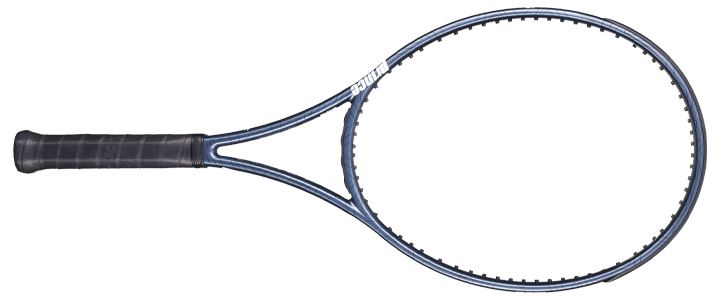
The third generation of the Prince Phantom 100 received some welcome upgrades in 2020 while maintaining the core characteristics that made it popular. Overall, it’s an excellent improvement on a frame that continues to get better with each new release.
With its 100 in² head, the Phantom provides ample surface area to make a clean connection with the ball and avoid mishits. It also features an open 16×18 string pattern that provides access to generating topspin without working too hard.
One significant change to the frame vs. the prior model is its thicker, more powerful beam, increasing the stiffness rating from 54 to 58. Despite the change, the racquet weight remains the same at 11.4 ounces strung and will continue to suit players looking for an arm-friendly, control-oriented racquet.
One unique aspect of the Phantom 100X 305 is that it maintains stability without dramatically increasing its stiffness rating through Textreme, Prince’s ultra-thin carbon baked directly into the frame. However, this model enhances things further with their Anti-Torque System, which combines Texteme with the aramid Twaron to deliver added power without sacrificing stability.
Like the previous version, the Phantom 100X 305 takes full advantage of the Constant Taper System (CTS) that transitions from a thinner 18 mm shaft for flexibility and feel to a thicker 22 mm head to maintain a bit more power for a responsive racquet that delivers pace when you need it.
Overall, with a slant toward intermediate to advanced players, Prince has done a great job continuing to evolve the Phantom, which maintains its spot on my list of the best racquets.
Why I Love It
Here are the three key reasons I enjoyed the Phantom 100X 305.
Control
From the baseline, the Phantom 100X 305 provided respectable control with the ability to generate plenty of topspin that allowed me to dictate points accurately. I was even more delighted when I approached the net, as the racquet’s flexible frame helped me maintain control and direct the ball where I needed it. I felt the Phantom 100X 305 improves quite a bit from its predecessor at the net.
Maneuverability
Keeping most of the weight in the handle at 6 points head light, the Phantom 100X 305 also maintains plenty of maneuverability despite its mid-range 11.4-ounce weight. The head light balance was particularly beneficial up at the net, where I never felt like I had to force the racquet into position. It just came along for the ride.
Comfort
The Phantom 100X 305 is one of the most comfortable racquets I’ve played with, making it an excellent option for players needing an arm-friendly companion.
Tradeoffs
Overall, the Prince Phantom 100X 305 is a well-rounded tennis racquet that will likely suit various styles of play. Some players may find the racquet lacks in the power department, but it’s a tradeoff you’ll be making for the added control the frame delivers.
Specs
| Head Size | 100 in² / 645.16 cm² |
| Length | 27 in / 68.58 cm |
| Balance | 6 points HL |
| Weight (strung) | 11.4 oz / 323 g |
| Swingweight | 321 |
| Stiffness | 58 |
| Beam Width | 22mm / 120.5mm / 18mm |
| String Pattern | 16 Main / 18 Cross |
Ratings
Variations
- 97P
- 100P
- 100x 305
- 100X 290
- 100X 18×20
Wilson Burn 100
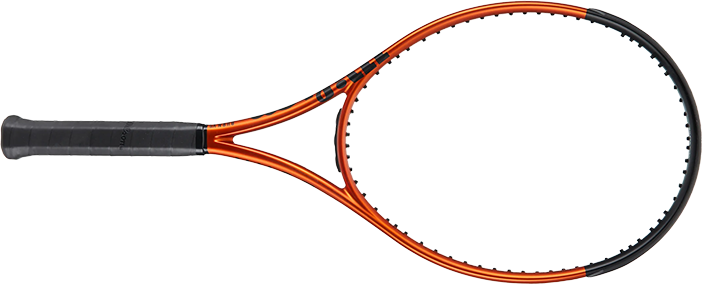
The Wilson Burn 100 v5 is the fifth generation of the original Wilson Burn, with specs and performance characteristics geared toward a wide range of intermediate to advanced tennis players.
Overall, the Burn 100 v5 is a well-balanced tennis racquet that produces excellent topspin and fantastic performance off the baseline and with returns.
This version of the Burn features Wilson’s rigid Carbon Fiber Graphite and a thicker variable-width beam for a crisp and responsive feel with plenty of power. At 11.2 ounces strung, it swings fast to generate higher levels of racquet head speed, which is necessary for producing maximum topspin.
Like many of the frames in the Wilson family, the Burn 100 v5 racquet also takes advantage of Wilson’s parallel drilling, with all grommet holes drilled parallel to the frame to increase the size of the sweet spot while delivering a more forgiving feel.
One of the things I love about the latest update to the Burn is its minimalist approach to racquet design. There aren’t many bells and whistles, but you get a terrific racquet that’s particularly well-suited for intermediate players.
Why I Love It
These are the main reasons I loved playing with the Wilson Burn 100 v5.
Groundstrokes
Off the baseline, the Wilson Burn 100 v5 excelled. At 4 points head light the racquet swings fast to generate topspin, enhanced by the 100 square inch head size and open 16×19 string pattern. As a stiffer racquet, it also packs a punch, playing perfectly into the modern game where these attributes are crucial.
Returns
With improved maneuverability over the original Wilson Burn, I found that this upgraded version performed well on returns and had respectable stability. This security gave me the confidence to swing through the ball while allowing me to block or slice back some of the bigger serves I returned.
Topspin
I enjoyed the topspin the Burn 100 v5 provided on both my groundstrokes and returns. Its 100 in² head combined with the open 16×19 string pattern allowed for plenty of grip, with the topspin coming naturally, especially when paired with a poly.
Tradeoffs
The Wilson Burn 100 v5’s higher power level may leave some players wanting to tone things down, but its excellent topspin can help offset the power – so your style of play is a factor here.
Another thing to remember is that this racquet is on the higher end of the spectrum regarding stiffness. Players may find less comfort, but it’s an improvement over the first generation.
Specs
| Head Size | 100 in² / 645.16 cm² |
| Length | 27 in / 68.58 cm |
| Balance | 4 points HL |
| Weight (strung) | 11.2 oz / 318 g |
| Swingweight | 320 |
| Stiffness | 72 |
| Beam Width | 23.5mm / 25mm / 23.5mm |
| String Pattern | 16 Main / 19 Cross |
Ratings
Variations
- 100 v4
- 100S v4
- 100LS v4
- 100ULS v4
Prince Warrior Textreme 100
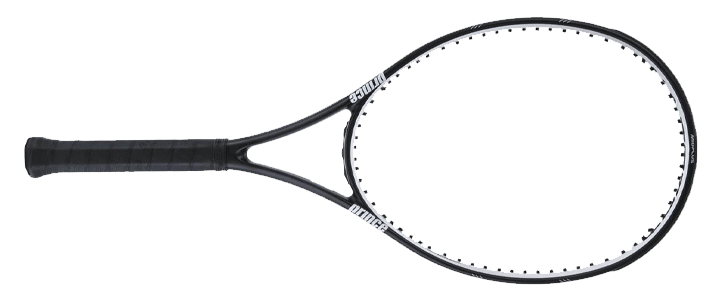
The two attributes that best describe the Prince Warrior Textreme are power and spin. The 100 in² head, open 16×18 string pattern, and a slightly higher flex rating of 66 combine to produce plenty of pop and more than enough grip to enhance your topspin.
This updated version of Prince’s Warrior 100 integrates Textreme, a specialized ultra-thin carbon fiber fabric that increases strength and rigidity without adding considerable weight. The result helps enhance the racquet’s power, control, and feel.
With a strung weight of only 11.4 ounces, less weight in the racquet head at 6 points head light, and a lower 320 swingweight, it’s a user-friendly tennis racquet that most players should find easy to maneuver.
Overall, the Prince Warrior Textreme 100 is a great tennis racquet that errs on the side of power while providing balance in other areas, such as control and feel, to appeal to a wide range of tennis players.
Why I Love It
The top three reasons I loved hitting with this tennis racquet are as follows.
Power
When playing with the Warrior Textreme, power came easily through a combination of attributes blended by Prince. I enjoyed the power from the back of the court, where the racquet felt ideally suited for trading big groundstrokes with my opponent.
Spin
The 100 in² head, combined with the open 16×18 string pattern, gave me plenty of bite and allowed me to generate more topspin on my shots without working too hard.
Groundstrokes
My favorite area of the court to play with the Prince Warrior Textreme 100 was from the baseline, where the racquet delivered power and spin. Similarly, I found the Warrior Textreme to work well hitting returns, where the 6-point head light balance allowed me to maneuver the racquet quickly and easily.
Tradeoffs
While the Warrior Textreme’s power certainly isn’t overbearing, it may leave some players longing for more control. In particular, that control could be handy at the net, where I had to maintain some extra focus.
Specs
| Head Size | 100 in² / 645.16 cm² |
| Length | 27 in / 68.58 cm |
| Balance | 6 points HL |
| Weight (strung) | 11.14 oz / 315.81 g |
| Swingweight | 320 |
| Stiffness | 66 |
| Beam Width | 24mm / 25.5mm / 22.5mm |
| String Pattern | 16 Main / 18 Cross |
Ratings
Variations
- 100
- 100T
- 100L
- 107
- 107T
- 107L Pink
Players Using or Endorsing
- John Isner
Prince ATS Textreme Tour 100P
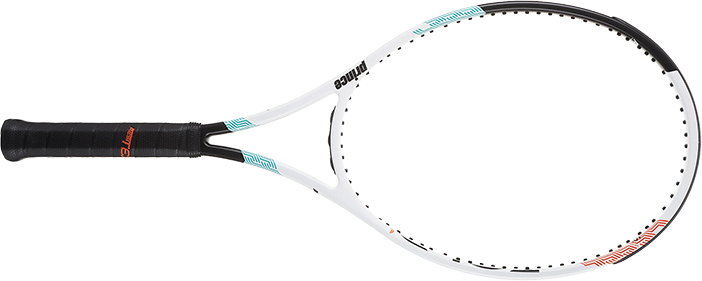
Players who have previously considered the Textreme Tour 100P and are back on the hunt will be delighted to find this racquet has received a few positive tweaks to improve its flex and stability while remaining true to the original design.
Like its predecessor, if you could sum up the revised Prince ATS Textreme Tour 100P in one word, it would be balance. Across the board, the racquet delivers excellent performance for players seeking a well-rounded racquet that’s reliable on all shots.
Like other frames in the lineup, the Tour 100P features Prince’s unique Textreme material. This super-thin carbon fiber fabric integrates directly into the tennis racquet’s shaft (handle and throat) to enhance stability and control.
However, this is where one of the tweaks to this model comes into play. Prince blends the Textreme formula with Twaron in the shaft and the racquet’s hoop at 10 and 2 o’clock. This new Anti-Torque System (ATS) enhances power and stability.
These changes result in a more flexible frame, reducing its stiffness from 66 to 61 to reduce shock for a more comfortable and forgiving response.
The latest model matches the prior model’s weight at 11.4 ounces and has a near-identical swingweight of 322. Combined with a 100 in² head size, 18×20 string pattern, and stiffness rating of 61, this racquet’s design will cater to a wide range of players.
It’s worth noting that even though the racquet weighs 11.5 ounces, its 7-point head light balance allows players to generate plenty of racquet head speed necessary to produce topspin on their shots.
Overall, the Prince ATS Textreme Tour 100P remains an approachable tennis racquet perfect for players seeking all-court performance.
Why I Love It
Here are the top three attributes I enjoyed while hitting with the Prince ATS Textreme Tour 100P.
Control
Prince’s ingredients come together nicely on the court and deliver great control. The racquet is solid off the ground, giving me the confidence to swing through the ball and hit my spots.
Comfort
With its 11.5-ounce weight, mid-range stiffness rating of 61, and head light balance that keeps the weight in the handle, the ATS Textreme Tour 100P absorbs the shock and vibrations that come with each shot and provides excellent comfort.
Touch and Feel
The same combination of specs and materials that help deliver solid control also provides a terrific feel. I felt connected trading groundstrokes, and up at the net, I was delighted with my ability to direct the ball with a high level of accuracy.
Tradeoffs
With the Prince ATS Textreme Tour 100P, you’ll get a balanced performance but won’t be wowed in any particular area.
For example, there were times when I would have preferred a bit of extra power or topspin. Depending on your preference, that may be a drawback that may drive you to look elsewhere.
Specs
| Head Size | 100 in² / 645.16 cm² |
| Length | 27 in / 68.58 cm |
| Balance | 7 points HL |
| Weight (strung) | 11.4 oz / 323 g |
| Swingweight | 322 |
| Stiffness | 61 |
| Beam Width | 22mm / 23mm / 20mm |
| String Pattern | 18 Main / 20 Cross |
Ratings
Variations
- Tour 95
- Tour 98
- 100 (290)
- 100 (310)
Tecnifibre TF-X1 300

Released in 2021, the TF-X1 is part of one of two competition-level tennis racquet lines that Tecnifibre offers, which delivers exceptional power and features designed to help minimize shock and vibration.
For power, the racquet uses a 100 in² head size and a unique frame geometry with a rounder head, grooves within the bumper, and specially reinforced sections called Isoflex. Tecnifibre pairs these features with an open 16×19 string pattern for easier access to spin.
At 11.1 ounces and with a 4 pt HL balance, the TF-X1 300 is an easy-to-man maneuver frame for quick reactions up at the net, generating maximum racquet head speed for topspin.
The frame is on the stiffer end of the spectrum with an RA or stiffness rating of 71 and a thicker 24 mm beam. However, to aid comfort, Tecnifibre introduces their X-Damp system, visible at the bottom of the racquet’s handle, to reduce shock and vibration by 36%.
If it sounds familiar, the vibration-dampening system is an updated version of one that Rene Lacoste previously developed.
Overall, the Tecnifibre TF-X1 300 is a relatively well-balanced frame that offers explosive power and spin designed for a wide range of players, especially those who love to trade big groundstrokes.
Why I Love It
These are the three reasons I loved the Technifibre TF-X1 300.
Power
With the TF-X1 300’s 100 in² head and high stiffness rating of 71, the racquet delivered plenty of power that came rather effortlessly but, at the same time, didn’t feel entirely overbearing.
Groundstrokes
I enjoyed the power of this frame most at the baseline. I settled in quickly with the racquet and found I could trade big shots and play great offense with plenty of topspin, taking advantage of the open 16×19 string pattern.
Maneuverability
At 11.1 ounces and with a 4-point head light balance, this lightweight frame is easy to maneuver, offers excellent preparation on my groundstrokes, and delivers easy handling up at the net.
Tradeoffs
As a frame with a mid-range weight and head light balance that’s very easy to maneuver, I found the Tecnifibre TF-X1 300 to provide less stability, particularly when returning bigger serves.
At the same time, I felt that the stiffer frame, which helps provide the racquet’s power, was lacking in the comfort department and required me to work harder to find that effortless touch at the net.
Specs
| Head Size | 100 in² / 645.16 cm² |
| Length | 27 in / 68.58 cm |
| Balance | 4 points HL |
| Weight (strung) | 11.1 oz / 315 g |
| Swingweight | 323 |
| Stiffness | 71 |
| Beam Width | 24mm / 24mm / 24mm |
| String Pattern | 16 Main / 19 Cross |
Ratings
Variations
- TF-X1 300
- TF-X1 285
- TF-X1 275
Head Extreme MP 2022
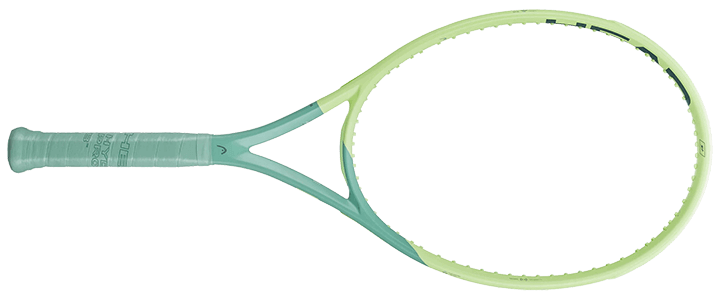
A few years ago, this frame showed up on my list of the best tennis racquets for the first time, and it remains a contender this year.
The Head Extreme MP is a mid-weight racquet geared toward intermediate to advanced players who like to hit with topspin and authority. It’s fitting as Frenchman Richard Gasquet and Italian tennis player Matteo Berrettini both use it.
This racquet offers a reasonable and approachable weight at 11.2 ounces strung, and its swingweight is 325. It also has a middle-of-the-road stiffness rating of 66, which won’t deliver the highest comfort level but shouldn’t cause most players any issues in this department.
The Extreme Pro’s 100 in² head combines its 16×19 string pattern and Spin Grommet technology in the mains and Sound Grommets in the crosses to enhance string movement and increase snapback. The net result is a racquet that can deliver substantial topspin and considerable pace.
Last but not least, this racquet features Graphene to reduce weight in the racquet’s midsection while reinforcing the head of the racquet at 3, 9, and 12 o’clock on the racquet’s head to aid stability and power.
New for this release, Head introduces an Auxetic construction at the top of the racquet’s throat, called the yoke or bridge, which dynamically responds to the force for optimal performance.
Overall, if you’re looking for a spin-friendly tennis racquet that doesn’t skimp on power while being user-friendly, then the Head Extreme MP 2022 is worth checking out.
Why I Love It
Here’s why I dig with the Head Extreme MP.
Groundstrokes
Based on the description, it shouldn’t be surprising that this tennis racquet is well-suited for the baseline. The racquet swings fast, delivering excellent spin and loads of power, and it’s adequately stable for its weight, which is ideal for the modern game.
Power
While the Extreme MP isn’t the most powerful racquet on the market, it holds its own and rivals some of the best in this category. You won’t have to try too hard to turn things up a notch, but I didn’t find it overbearing, which is ideal for experienced players. On serve, the power is perfect.
Topspin
I loved the topspin I could produce with this racquet. It felt solid at impact, but it gripped the ball and gave me the confidence to swing big with a high margin for error, knowing the ball would drop back into the court.
Tradeoffs
Although I didn’t have any significant issue with this frame, some players will find this racquet’s power a bit overbearing, and if you like to flatten out the ball, it won’t be the racquet for you. However, players who prefer to hit with lots of spin will likely be at home with it.
Specs
| Head Size | 100 in² / 645.16 cm² |
| Length | 27 in / 68.58 cm |
| Balance | 3 points HL |
| Weight (strung) | 11.2 oz / 318 g |
| Swingweight | 322 |
| Stiffness | 66 |
| Beam Width | 23mm / 26mm / 21mm |
| String Pattern | 16 Main / 19 Cross |
Ratings
Variations
- Extreme Pro
- Extreme MP
- Extreme Lite
- Extreme PW
- Extreme S
Players Using or Endorsing
- Richard Gasquet
- Matteo Berrettini
- Jan-Lennard Struff
- Svetlana Kuznetsova
Tecnifibre T-Fight 300 Isoflex
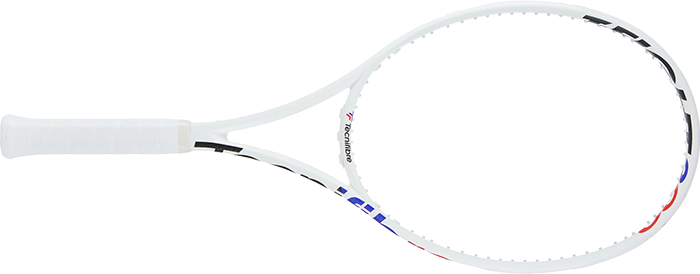
This year, the TFight 300 ISOFLEX makes the cut as a slick-looking and approachable mid-weight racquet that delivers balanced performance with plenty of access to topspin and power.
The ISO 300 has a 98 in² head and a manageable 11.2-ounce weight. It also offers an open 16×19 string pattern, which, when combined, ensures a fast-swinging racquet that grips the ball for generating loads of topspin.
New for this model, Tecnifibre introduces Isoflex, progressively enhancing its stiffness throughout the frame for greater stability and an improved response. This technology is paired with a unique frame design or RS Section, with five sides at strategic angles for added stability and improved response and comfort.
The frame’s power derives from a combination of its stiffness, rated at 66 and 22.5 mm beam, which helps return substantial energy to the ball. However, Tecnifibre complements these attributes with a foam injection for comfort and enhanced feel.
Overall, Tecnifibre’s TFight 300 Isoflex is a well-rounded tennis racquet whose lighter weight and all-court performance are sure to please a wide range of tennis players.
Why I Love It
Here’s why I love the Tecnifibre TFight 300 Isoflex.
Groundstrokes
The Tecnifibre TFight 300 Isoflex had plenty of pop from the baseline, which I could control with quick racquet head speed and topspin. Simultaneously, the 98 in² head and a slightly thinner beam gave me the control to direct the ball and hit my spots.
Volleys
The racquet is easy to maneuver, but it packs a punch at the net, which helped me put away my shots as I moved forward.
Returns
Despite its lighter weight, the 300 Isoflex performs well on returns. It’s easy to bring the racquet back and swings fast to take a substantial cut at softer serves while staying reasonably solid through contact to handle extra pace when needed.
Tradeoffs
While I felt the frame was a tad stiff at times, the biggest drawback I think players will find with this racquet is that it doesn’t wow in any one area – which, at the same time, is the racquet’s strength.
Players looking for a highly controlled, heavier racquet or a more powerful frame will want to look elsewhere, while players looking for a balanced, well-rounded racquet will be right at home with the 300 Isoflex.
Specs
| Head Size | 98 in² / 632.26 cm² |
| Length | 27 in / 68.58 cm |
| Balance | 4 points HL |
| Weight (strung) | 11.2 oz / 318 g |
| Swingweight | 320 |
| Stiffness | 66 |
| Beam Width | 22.5mm / 22.5mm / 22.5mm |
| String Pattern | 16 Main / 19 Cross |
Ratings
Variations
- 295 Isoflex
- 300 Isoflex
- 315 Isoflex
Players Endorsing the T-Fight Line
- Daniil Medvedev
- Iga Swiatek
- Chris Eubanks
- John Millman
- Jeremy Chardy
- Aljaz Bedene
- Denis Istomin
Head Radical MP
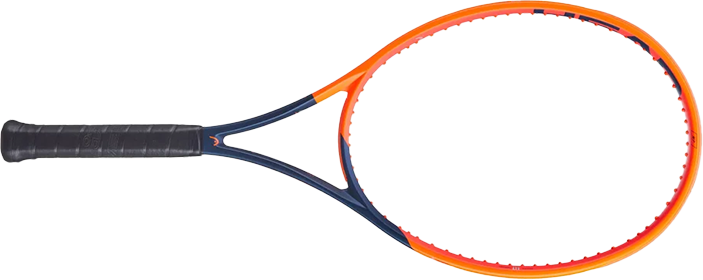
The Head Radical MP 2023 is a solid option for intermediate to advanced players.
The racquet weighs 11.2 ounces strung and offers a 4pt HL balance. Combined, these attributes result in a 323 swingweight that’s easy to swing to generate excellent topspin aided by an open 16×19 string pattern and a 98 in² head size for control.
This model’s latest generation from the Radical lineup uses Head’s Graphene 360+ technology in the shaft and at 3, 9, and 12 o’clock in the frame’s head for optimal stability and power.
Like the previous model, you’ll find Head’s Control Pattern, which decreases the spacing between the eight mains at the racquet’s center for improved control without giving up the benefits of its 16×19 string pattern.
New for this generation, Head tops it off with their Auxetic construction for the frame’s yolk (the section at the bottom of the head that bridges the throat) to enhance flex and deliver improved response for greater feedback.
Why I Love It
Here are a few of the top reasons the Head Radical MP 2023 made my list this year.
Groundstrokes
If I were to pick a single area where this racquet excels, it would be hitting groundstrokes. The frame swings easily and offers moderate power that relies on the player’s skill and technique, an ideal setup for an intermediate to advanced player.
Topspin
Although it’s not the most spin-friendly racquet on the market, it does surprisingly well. Again, it swings fast, a key ingredient for generating topspin, and the 16×19 string pattern delivers plenty of grip.
Maneuverability
No matter where you are on the court, the Head Radical MP moves easily to ensure your racquet is positioned. From serves to volleys, the racquet is quick, and I especially appreciated this attribute when hitting returns.
Tradeoffs
Although the Head Radical MP 2023 isn’t a lightweight racquet, at 11.2 ounces and featuring a 4pt HL balance, it feels light in hand, and I found it to lack stability. Combined with its mid-range stiffness of 65, it’s not the most comfortable.
Specs
| Head Size | 98 in² / 635.26 cm² |
| Length | 27 in / 68.58 cm |
| Balance | 4 points HL |
| Weight (strung) | 11.2 oz / 318 g |
| Swingweight | 323 |
| Stiffness | 65 |
| Beam Width | 20mm / 23mm / 21mm |
| String Pattern | 16 Main / 19 Cross |
Ratings
Variations
- Pro
- Team
- XT MP
- XT S
Players Endorsing the Radical Line
- Andy Murray
- Taylor Fritz
- Diego Schwartzman
- Sloane Stephens
Wilson Ultra 100 v4
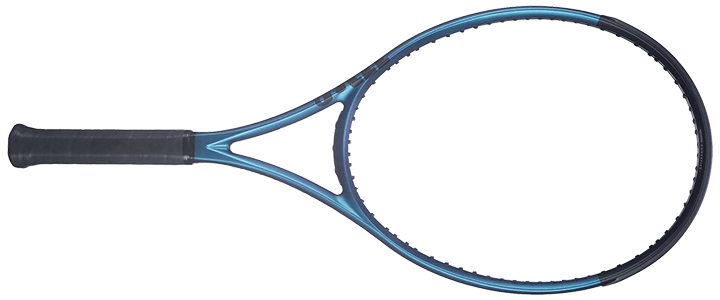
The Wilson Ultra 100 v4 is the fourth generation of this series, which stays true to its roots, delivering excellent power and spin.
New to this release, the Ultra 100 v4 now uses FORTYFIVE, Wilson’s proprietary graphite layup that improves flex without sacrificing stability and maintaining power. It’s the same technology they’ve slowly introduced to other lines, including the Wilson Blade, after its initial introduction to the Wilson Clash.
Wilson also has revised the racquet’s beam, reducing it by .5 mm in the shaft for added flex and comfort while increasing it slightly throughout the head to maintain power and stability.
Other noteworthy features include Wilson’s Parallel Drilling technology, which opens up the sweet spot and provides a more forgiving stringbed. You’ll also find a Sweet Spot Channel on the racquet’s head at three and nine o’clock, which increases the length of the cross strings in the mid-section to enhance string movement for added power.
The racquet also uses Wilson’s Crush Zone grommet system, which compresses and rebounds when striking the ball for extra power and dwell time for control. Plus, the grommets, bumper guard, and end cap are plant-based plastics to reduce the company’s environmental impact.
The net result is an approachable tennis racquet that should appeal to a broad range of players looking for an easy-to-manage frame that provides excellent power and topspin.
Why I Love It
Here are the top three reasons I love the Wilson Ultra 100 v4.
Power
As you may have noticed, much of this racquet’s design and feature-set gears toward helping players generate power with minimal effort. On the court, that power is apparent, and it’s by far the racquet’s most distinct feature, which was unmistakable from my first stroke – especially when paired with the frame’s sizeable sweet spot.
Topspin
I also enjoyed the Wilson Ultra 100 v4’s ability to generate topspin. The racquet’s lower 11.2-ounce weight and 312 swingweight make it easy to swing and generate racquet head speed, which is the primary source of topspin. Meanwhile, the frame’s 100 in² head and open 16×19 string pattern allow the strings to move freely and enhance spin.
Groundstrokes
The combination of power and topspin made groundstrokes my favorite stroke with the Ultra 100 v4. The frame felt easy to maneuver, and I didn’t have to work too hard to generate pace. You can expect the frame to deliver a consistent response while benefiting from a prominent sweet spot, making it more forgiving when hitting off-center shots.
Tradeoffs
While the increased power potential may be desirable for some players, it may leave others longing for control. I found this more apparent during my playtest when I looked to be aggressive with my shots. Ultimately, it forced me to be more conservative, hit with lots of topspin, and aim for larger targets to keep the ball in play.
Another point to remember is the frame’s higher stiffness rating of 70. Although it’s three points lower than its predecessor, it’s still high and may pose a challenge for players suffering from arm discomfort.
Specs
| Head Size | 100 in² / 645.16 cm² |
| Length | 27 in / 68.58 cm |
| Balance | 4 points HL |
| Weight (strung) | 11.2 oz / 318 g |
| Swingweight | 317 |
| Stiffness | 70 |
| Beam Width | 24mm / 26.5mm / 25mm |
| String Pattern | 16 Main / 19 Cross |
Ratings
Variation
- 100 v3
- 100L v3
- 100UL v3
- 108 v3
- 95 Countervail
- 25 v3 Junior
- 26 v3 Junior
Players Using or Endorsing
- Kei Nishikori
- Borna Coric
- Feliciano Lopez
- Madison Keys
- Kristina Mladenovic
- Victoria Azarenka
- Maria Sakkari
HEAD Instinct MP 2022

For the fourth straight year, the Head Graphene 360 Instinct MP, previously endorsed by Maria Sharapova and Tomas Berdych, remains a solid option for intermediate to advanced players.
With a moderate weight of 11.2 ounces, this racquet has a 100 in² head and a 16×19 string pattern, enabling excellent topspin. With a 4-point HL balance, the racquet swings relatively quickly and easily, further influencing a player’s ability to generate spin.
Like many other Head tennis racquets, the Instinct MP integrates Graphene 360 technology, which helps reduce weight within the racquet’s shaft while boosting its power and stability through the materials used in the racquet’s head at 3, 6, and 12 o’clock. The addition of SpiralFibers in the bottom portion of the frame’s head aims to improve the racquet’s feel while providing a better overall response.
Although it might not be the first attribute that comes to mind, the Head Instinct MP 2022 is an arm-friendly tennis racquet featuring a low-end stiffness or RA rating of 64.
It’s a well-rounded tennis racquet that is an excellent fit for intermediate players looking to move to a frame that offers speed, control, and playability without completely sacrificing power.
Why I Love It
Here’s why I loved playing with the Head Graphene 360+ Instinct MP.
Groundstrokes
My favorite place to hit with the HEAD Graphene 360+ Instinct MP was off the ground. As expected, it swings fast with its 4-point head light balance, which helped generate topspin, and it packs plenty of power to match while offering plenty of comfort.
Topspin
As a fast-swinging frame with a 16×19 string pattern, this tennis racquet allowed me to produce loads of topspin with plenty of power. This combination gave me confidence when hitting and helped me dictate points and keep my opponents on their heels.
Maneuverability
At 11.2 ounces and featuring a 4-point head light balance, the Head Graphene 360+ Instinct MP moves easily. Whether I’m bringing my racquet back for a return, serving, or approaching the net for a volley, it’s easy to maneuver and get into position.
Tradeoff
As a racquet with a mid-range weight that will appeal to many players, I felt the most significant tradeoff was the overall feel and stability. I sometimes wanted the extra mass on my returns and slice to help the racquet move more easily through the ball. However, if that’s a concern, you can address it by adding lead tape.
Specs
| Head Size | 100 in² / 645.16 cm² |
| Length | 27 in / 68.58 cm |
| Balance | 4 points HL |
| Weight (strung) | 11.2 oz / 318 g |
| Swingweight | 314 |
| Stiffness | 64 |
| Beam Width | 23mm / 26mm / 23mm |
| String Pattern | 16 Main / 19 Cross |
Ratings
Variations
- Instinct MP
- Instinct Team L
- Instinct PWR 110
- Instinct PWR 115
Dunlop FX 500
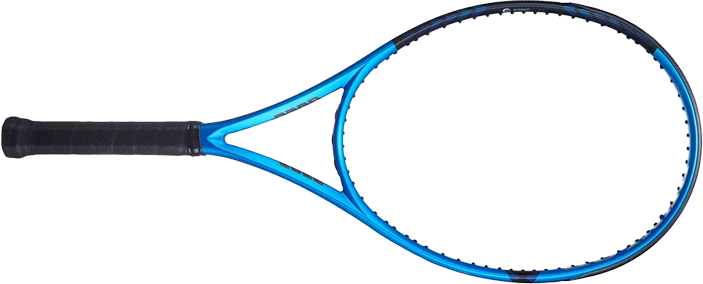
The latest generation of the Dunlop FX 500 pairs a 100 in² head with an open 16×19 string pattern and weighs in at 11.3 ounces strung with a 4 pt head light balance that results in a highly manageable swingweight of 321.
You’ll also find a higher-end stiffness rating of 69 and a thicker variable width beam that’s 23 mm at the throat, 26 mm at the sides of the head, and 23 mm at the top of the frame.
The frame’s construction is a mix of graphite and Sonic Core Infinergy, an expanded thermoplastic polyurethane placed at ten and 2 o’clock on the racquet’s head to improve the racquet’s response while decreasing unwanted vibrations.
Dunlop updates the frame with its Power Boost Frame Geometry, increasing the throat’s width for stability and implementing an aerodynamic design for faster swings and extra power.
Their team also updated the grommets with a larger groove cut into the frame to improve energy return and power and opened the string bed for better grip and spin.
Although this racquet won’t deliver plush comfort, Dunlop does lower the frame’s stiffness from 71 to 69 for this generation to help soften the response, a welcome update that improves feel.
Why I Love It
Here’s what stands out with the Dunlop FX 500.
Power
From the head size and stiffness to the frame’s thicker beam, I expected the Dunlop FX 500 to generate high power levels, and it didn’t disappoint. My favorite shots to hit with this frame were on groundstrokes and serves where you can turn up the pace.
Topspin
I also found the racquet delivered excellent topspin, and there are a few factors at work. The racquet’s reasonable weight makes it so you can swing fast, and the larger head and open string bed combine with their unique stringbed layout for optimal grip.
Maneuverability
As you might expect, the Dunlop FX 500 is also highly maneuverable. On returns, you can get the racquet back quickly, the head is responsive at the net, and on serve, it swings fast.
Tradeoffs
Although Dunlop has added some tech to reduce the shock and vibration associated with this high-powered frame, its stiffness and lower weight result in a less comfortable hitting experience.
The frame also lacks a bit in the stability department, so if you’re dealing with a heavy-hitting opponent, particularly on serve and at the net, you may find the racquet struggles to keep up.
Specs
| Head Size | 100 in² / 645.16 cm² |
| Length | 27 in / 68.58 cm |
| Balance | 4 points HL |
| Weight (strung) | 11.3 oz / 320 g |
| Swingweight | 321 |
| Stiffness | 69 |
| Beam Width | 23mm / 26mm / 23mm |
| String Pattern | 16 Main / 19 Cross |
Ratings
Variations
- FX 500 Tour
- FX 500 LS
- FX 500 Lite
- FX 700
Players Endorsing the FX Line
- Qiang Wang
Head Prestige Tour
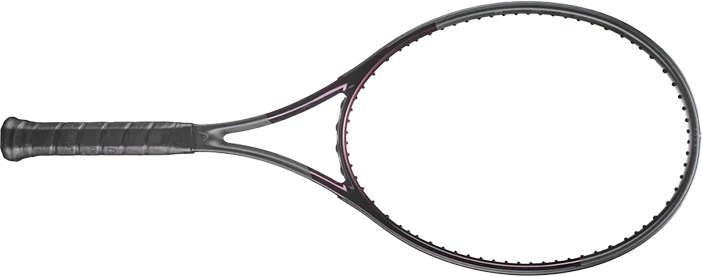
The Prestige line of tennis racquets offers a classic feel with smaller head sizes and heavier weights intended to provide players with maximum control and precision.
New for the latest generation, Head integrates their Auxetic 2 construction within the yoke (the bottom of the head that connects the two arms of the throat) and handle to improve feel and dampen vibrations. The Prestige Tour also continues to use Graphene 360+ to enhance stability, power, and feel.
As far as specs go, the racquet offers a 95 in², 11.7 oz strung weight, and a flat 22 mm beam, giving it the essential ingredients for delivering the controlled performance that strong intermediate to advanced players demand.
The racquet also uses a 16×19 string pattern for optimal spin, and its RA rating of 62 helps improve ball pocketing.
Overall, the Prestige family continues to deliver a classic frame with a few modern twists that bring it into the modern age.
Why I Love It
Here are a few reasons I dig this particular racquet.
Control
Hands down, my favorite quality delivered by the Head Prestige Tour is the control it offers. On groundstrokes, it puts the player in the driver’s seat by demanding sound technique and clean ball-striking to achieve precision. Add to that sufficient topspin for a bit of extra margin for error, and it works well in this area.
Stability
Stability is a mainstay of the Prestige line, and the Prestige Tour delivers as expected. Its heavier 11.7 oz weight and 6 pt HL balance result in a meaty swingweight of 3330 to stand up to whatever your opponent throws at you. However, despite its extra weight, it remains reasonably easy to maneuver for its class.
Feel
All of the Prestige Tour’s attributes combine for a racquet that delivers excellent feel from all areas of the court, especially at the net. I felt connected with the ball and confident in my approach, enabling me to hit with finesse and accurately direct the ball.
Tradeoffs
Despite the Head Prestige Pro’s well-balanced performance, there is some give-and-take. In particular, the racquet’s heavier weight can make it tricky for some players to manage, and it doesn’t offer easy access to power.
Specs
| Head Size | 95 in² / 612.9 cm² |
| Length | 27 in / 68.58 cm |
| Balance | 6 points HL |
| Weight (strung) | 11.7 oz / 332 g |
| Swingweight | 330 |
| Stiffness | 62 |
| Beam Width | 22mm / 22mm / 22mm |
| String Pattern | 16 Main / 19 Cross |
Ratings
Variations
- Pro
- MP L
Players Using or Endorsing
- Marin Cilic
- Gilles Simon
- Francisco Cerundolo
- Aslan Karatsev
Wrapping Up
There you have it! My list of the 24 best tennis racquets for 2024. If you’ve enjoyed this article, I encourage you to bookmark it and share it with your friends, family, and teammates who might find it useful.
Every year, I’ll update and refresh this content to consider the latest and greatest tennis racquets top racquet brands are releasing.
Do you have a question about the tennis racquets on this list, or want to recommend another frame for the community to check out? Feel free to share your thoughts in the comments below.
Play Better Tennis
Improve your game alongside our community of tennis players
Why join?
Discussion Boards
Join the conversation with other members of the community.
5 Point Friday
Read our weekly recap of the 5 most interesting things we dig up in tennis.
Trackbacks & Pingbacks
Leave a Reply
Want to join the discussion?Feel free to contribute!
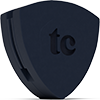


Amazing post! I’m using this “Yonex EZONE DR 98″ Tennis Racket” last 2 years & now it’s doing best. this is one of my favorite. Thanks for sharing your valuable post.
Hi Jennifer,
Thanks so much for your note – glad you enjoyed it! The Yonex EZONE DR 98 is a fantastic frame and one that continues to be loved by many players.
All the best,
Jon
i like your reviews , and thanks for sharing . My Favourite is Wilson Ultra 100 Countervail because i use it!
Thanks so much, and you’re welcome!
I own 3 racquets that I love but none of them make your list:
Dunlop Aerogel 1 Hundred
Prokennex i5 PSE
Donnay X-P Dual
These are masterpieces for anybody who has arm problems such as tennis elbow or golfers elbow. I don’t go for new rackets but for racquets that keep me healthy. There might be others out there, but these are the ones I do know.
Hi Oumar,
I love your suggestions for players looking for comfort. Thank you for taking the time to share!
All the best,
Jon
Lefthand player for 30 yrs. Mostly played with Head rackets but need change. maybe the Babolat-Pure. Im spin server, net charger. but weak two-hand backhand need more control in my game. Play with LXN 17 gauge springs at 62 lbs. head size 98.
Hi Will,
The Babolat Pure Drive will definitely help deliver excellent spin, but unfortunately its strong suit isn’t control. Have you looked into the Babolat Pure Strike?
All the best,
Jon
Amazing piece of review. I use a Babolat Pure Strike and find the racquet to be extremely good once you get the hang of it. Thanks for sharing this review.
Hi Kaoushik,
Excellent! Glad the Pure Strike has worked out for you. Thanks for your note.
All the best,
Jon
Can you review pls the Donnay Pro one 97 ?
Donnay claims that their solid-core tennis frames produce less shocks and vibrations at initial contact and 4 times less shock and vibration compared to other tennis rackets brands. Thus help reduce Arm & Shoulder pain & injuries .
I have a vulnerable shoulder condition , thus I’m very interested in their claim if it holds true . Thank you
Hi Karim,
Thank you for the suggestion, I’ll definitely keep it in mind.
All the best,
Jon
I feel like the Ezone shld be higher on the list
Hi John,
There are a lot of great racquets out there :) Thanks for sharing your thoughts.
All the best,
Jon
Very impressed with the testing and results. I noticed there were no Dunlop Racquets in the mix. Is that b/c there were none in the testing or they d/n make the cut of the top 25?
Thanks in advance for your reply………Norm
Hi Norm,
Thanks for dropping by! It’s a little further down the list, but you will find the Dunlop FX 500 as one of my top picks.
All the best,
Jon
In my opinion, after weeks of comparing the specs of different tennis rackets from the most trusted brands, the Wilson Pro Staff 97L CV became the best tennis racket overall. The Babolat Pure Strike was the best for babolat.
Hi Hanson,
That’s what it’s all about! Everyone needs to discover their own best racquet, so I’m glad you did your due-diligence and found yours. The Wilson Pro Staff 97L works great for many players.
All the best,
Jon